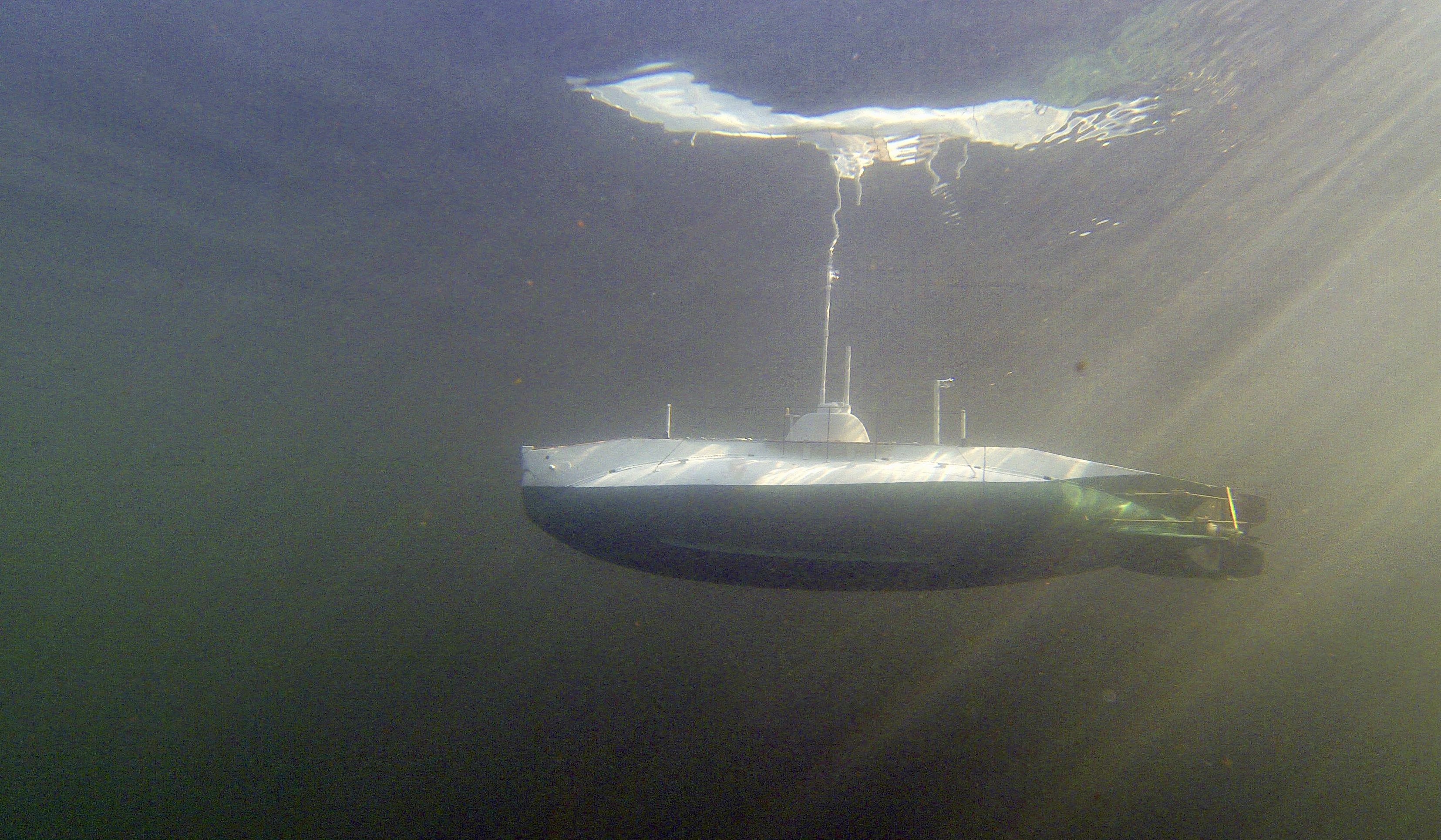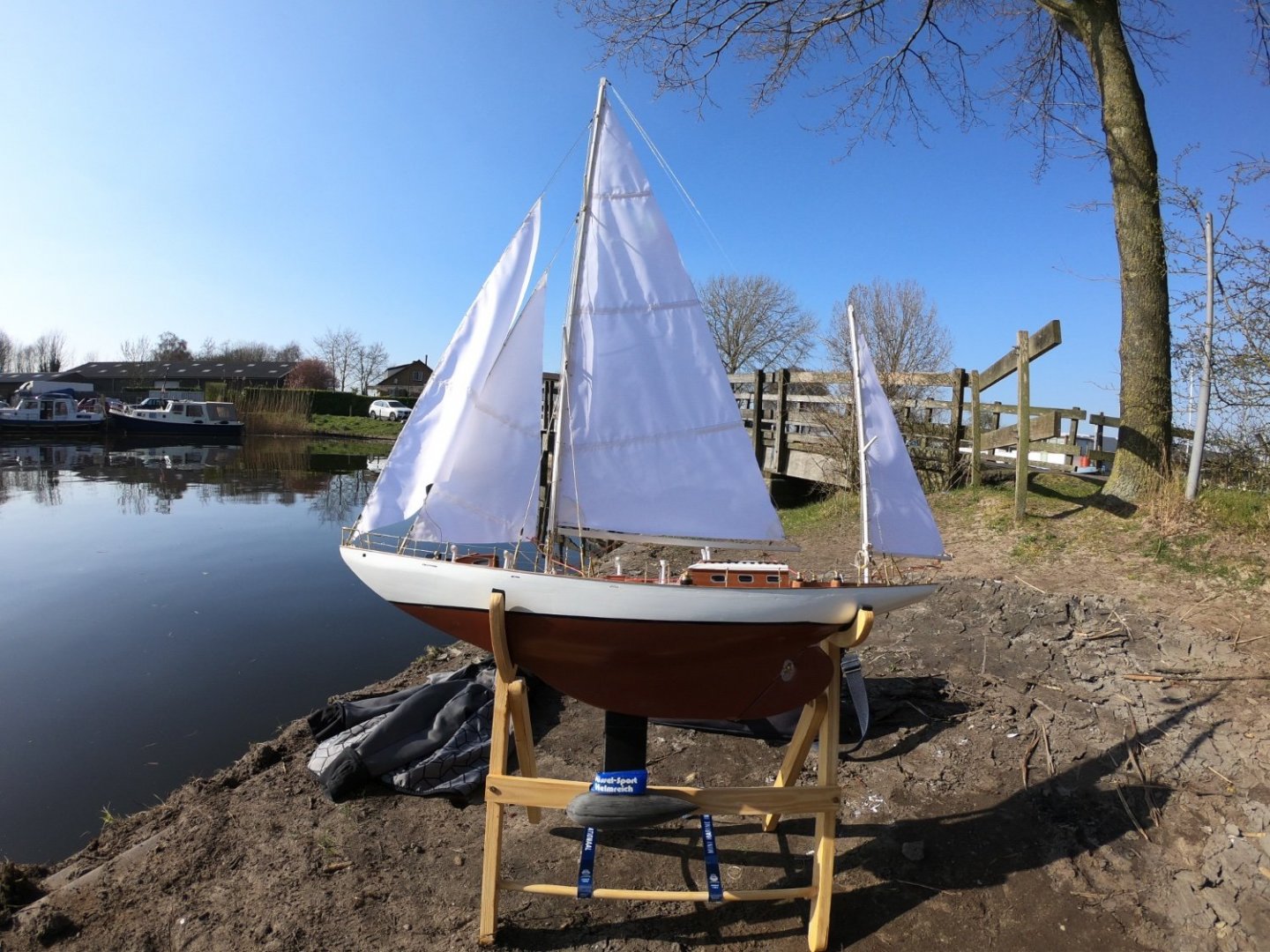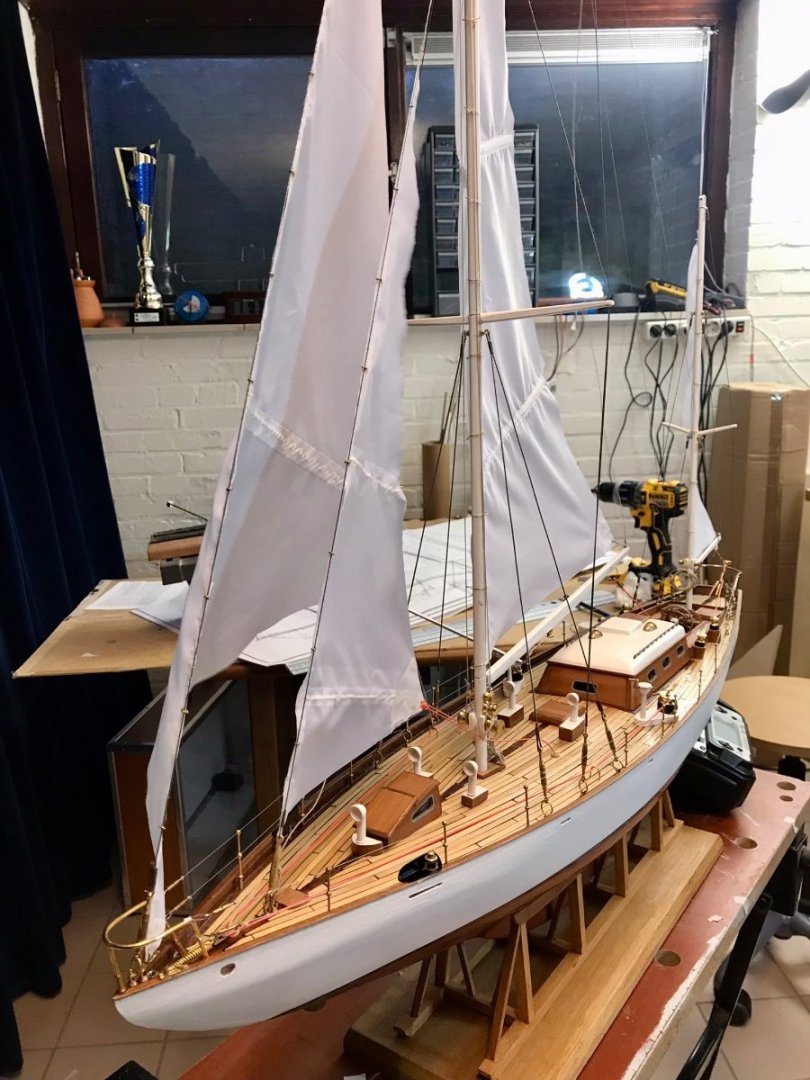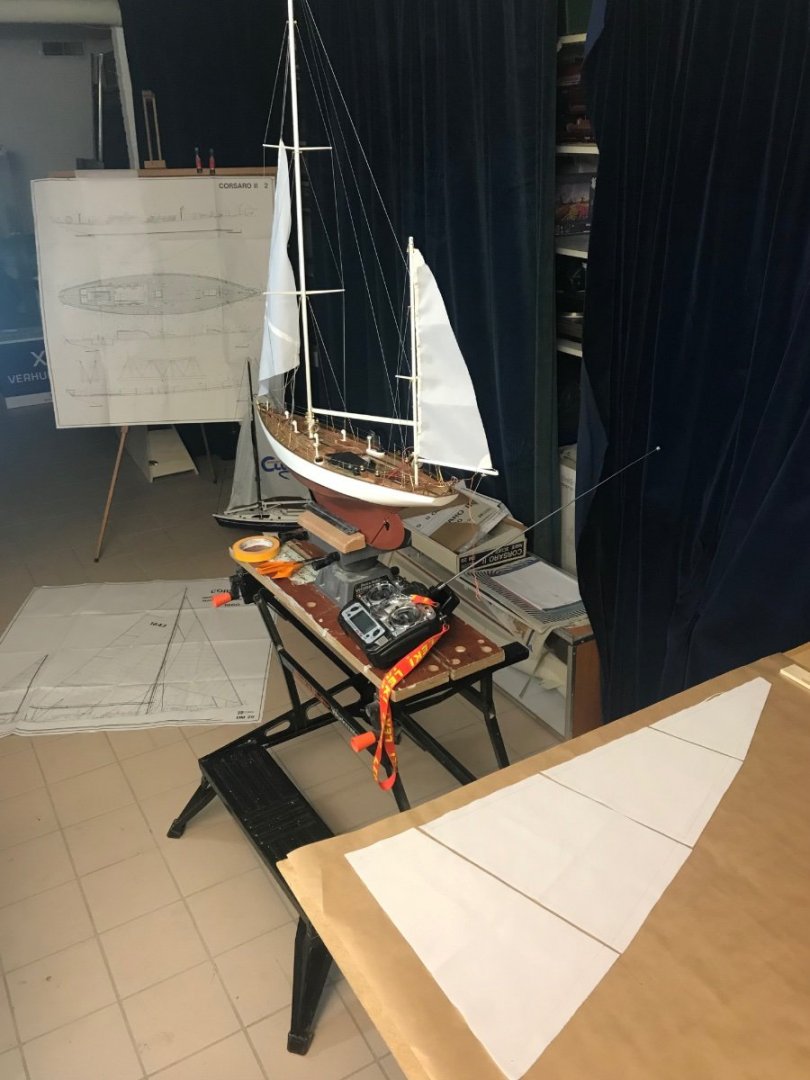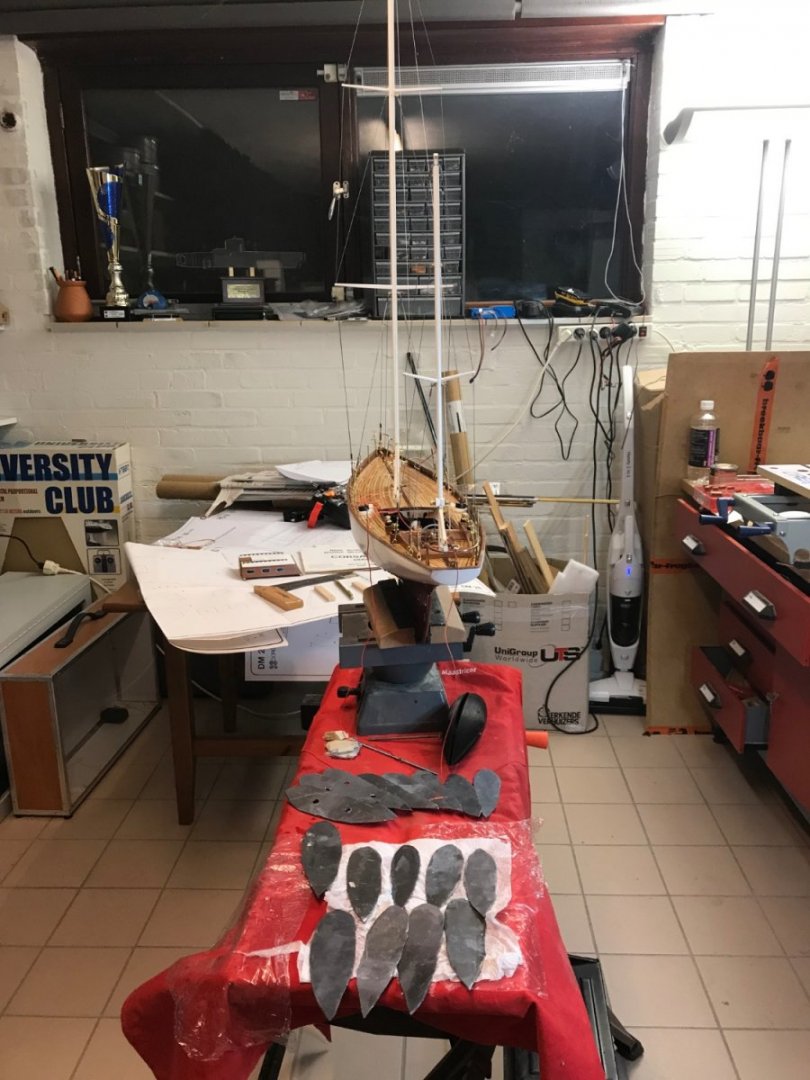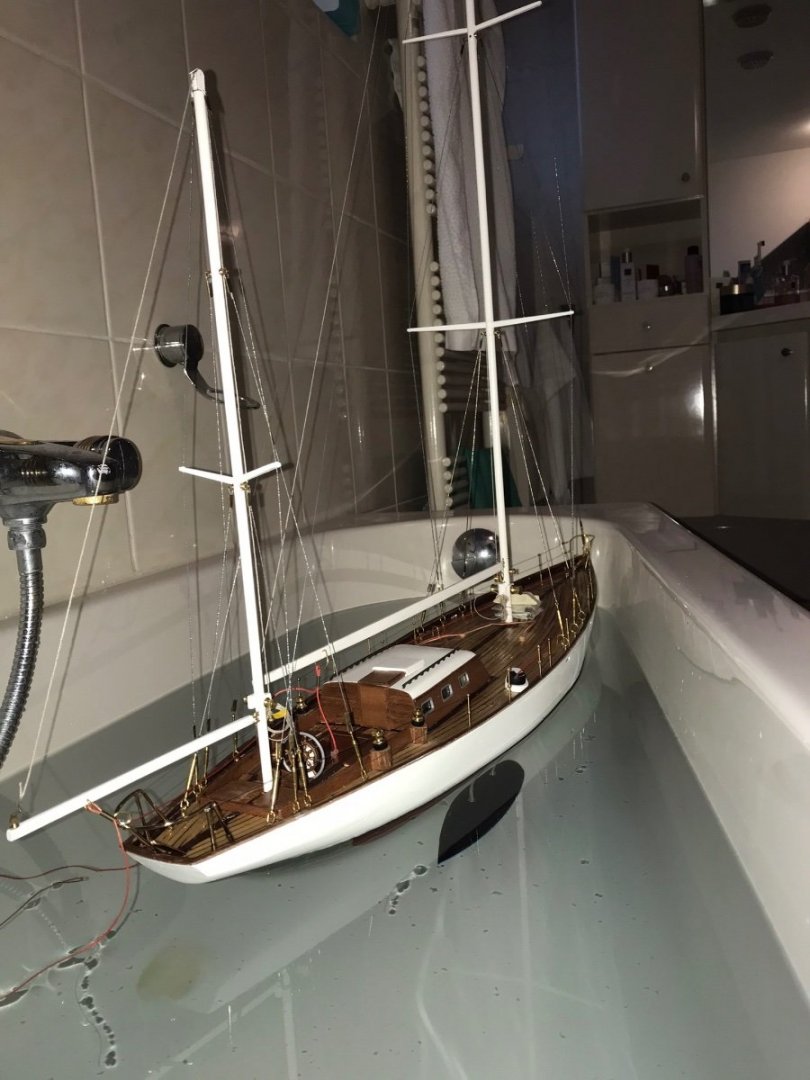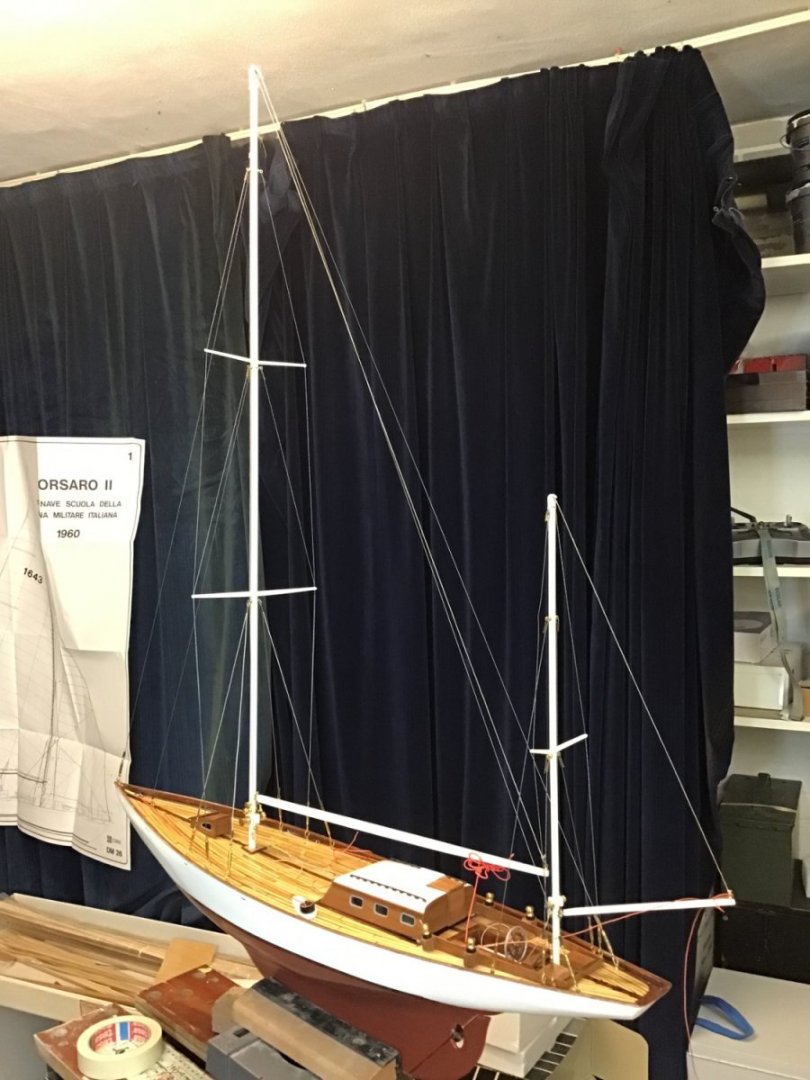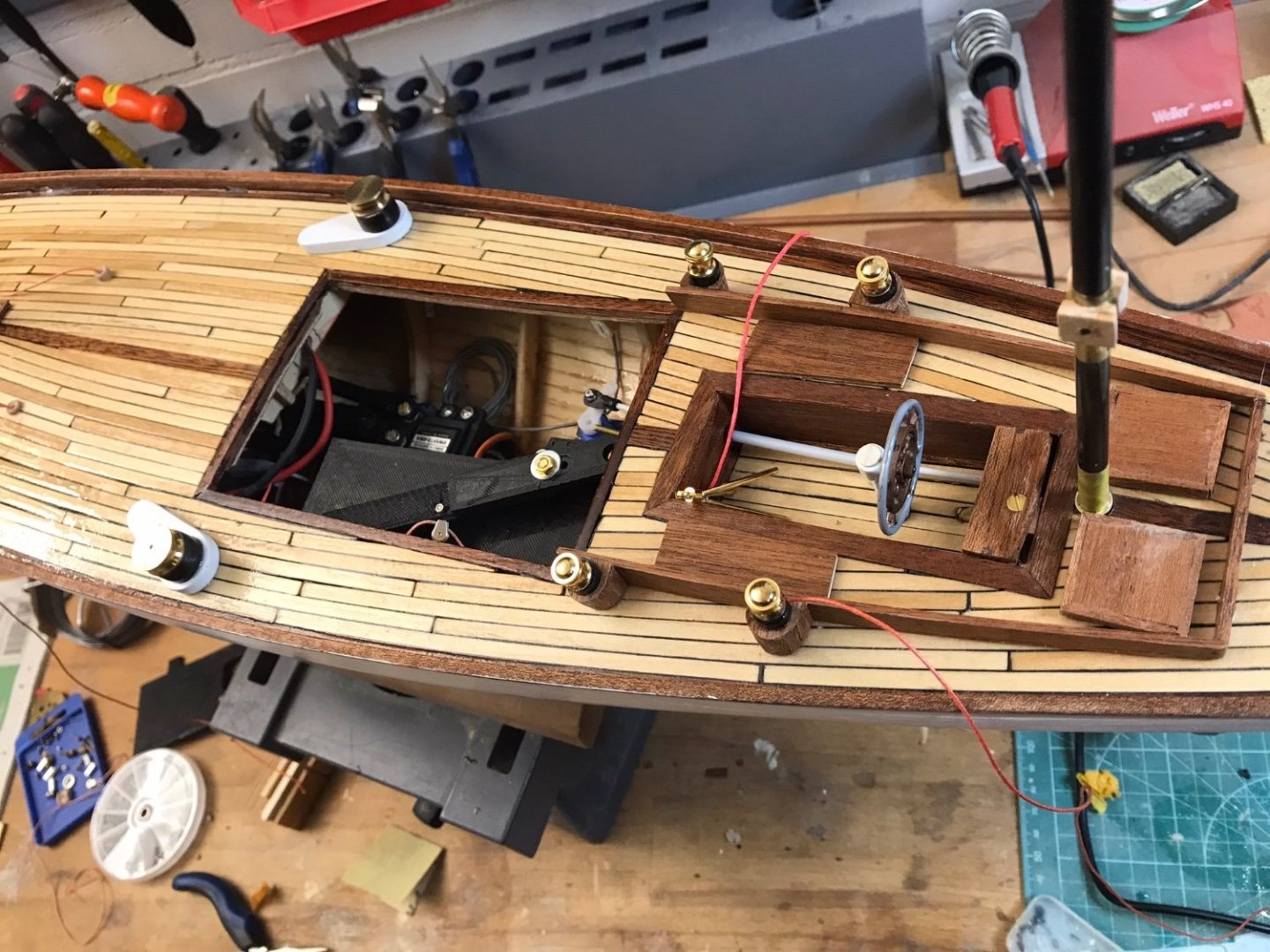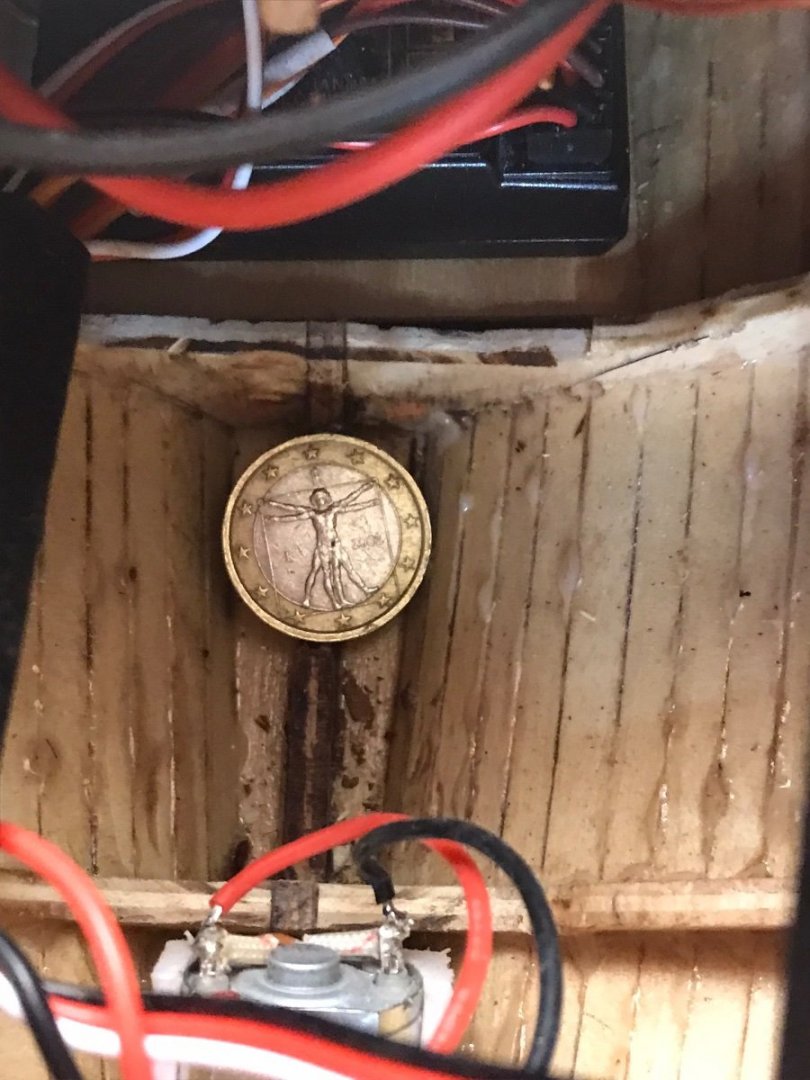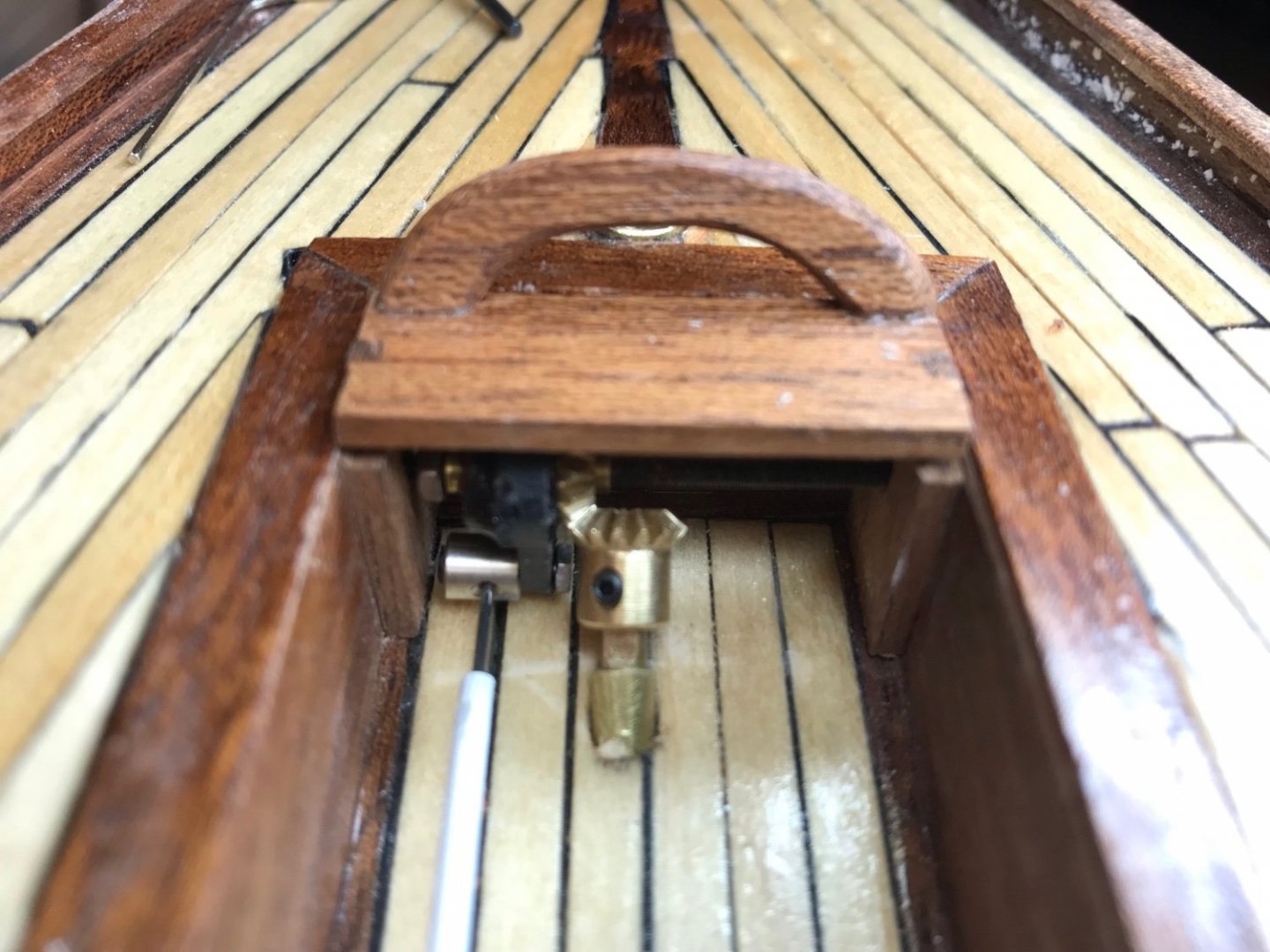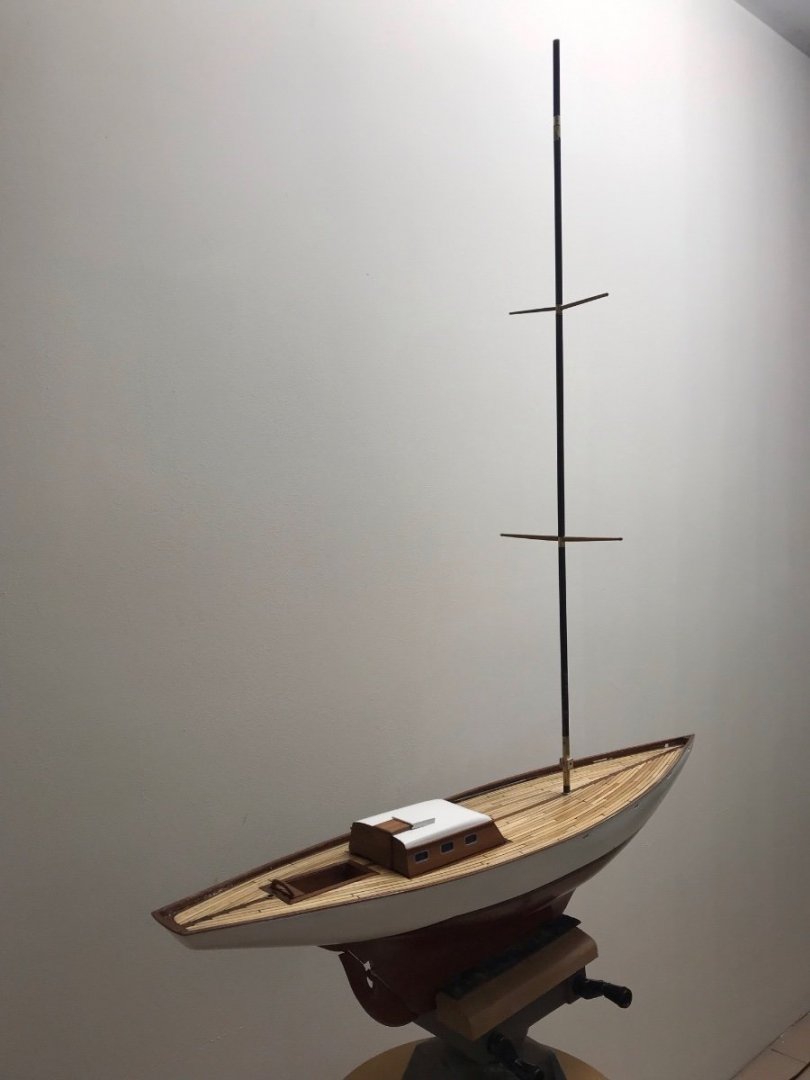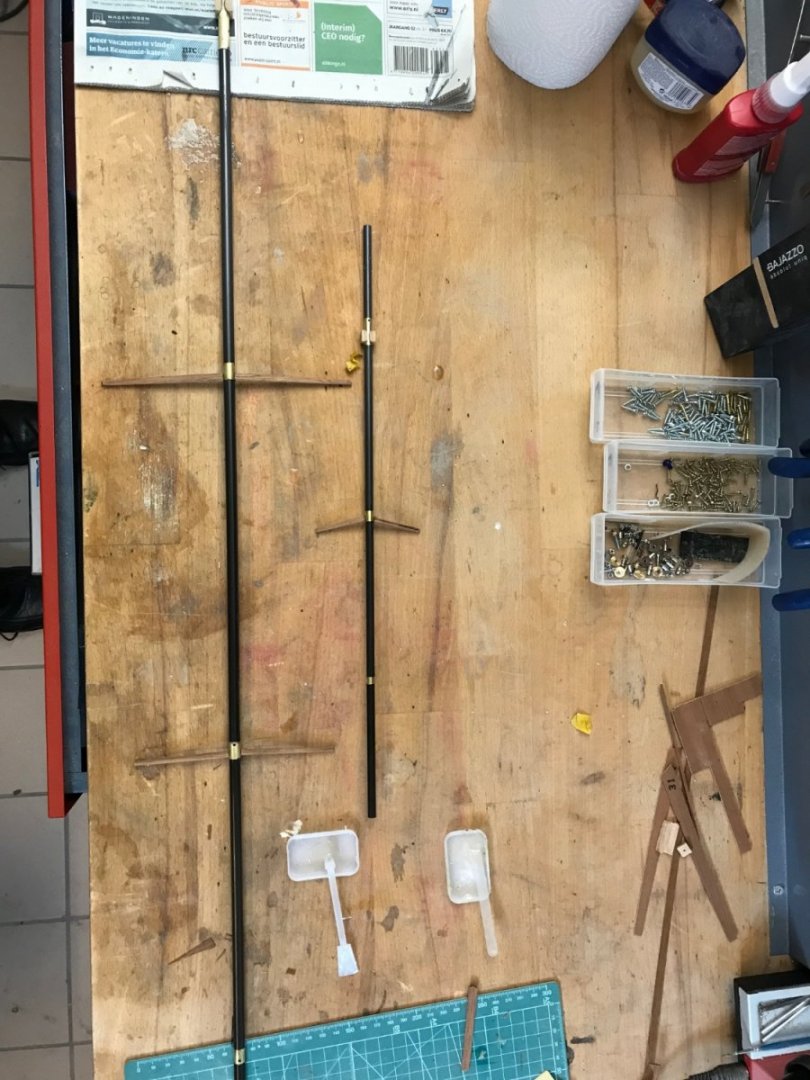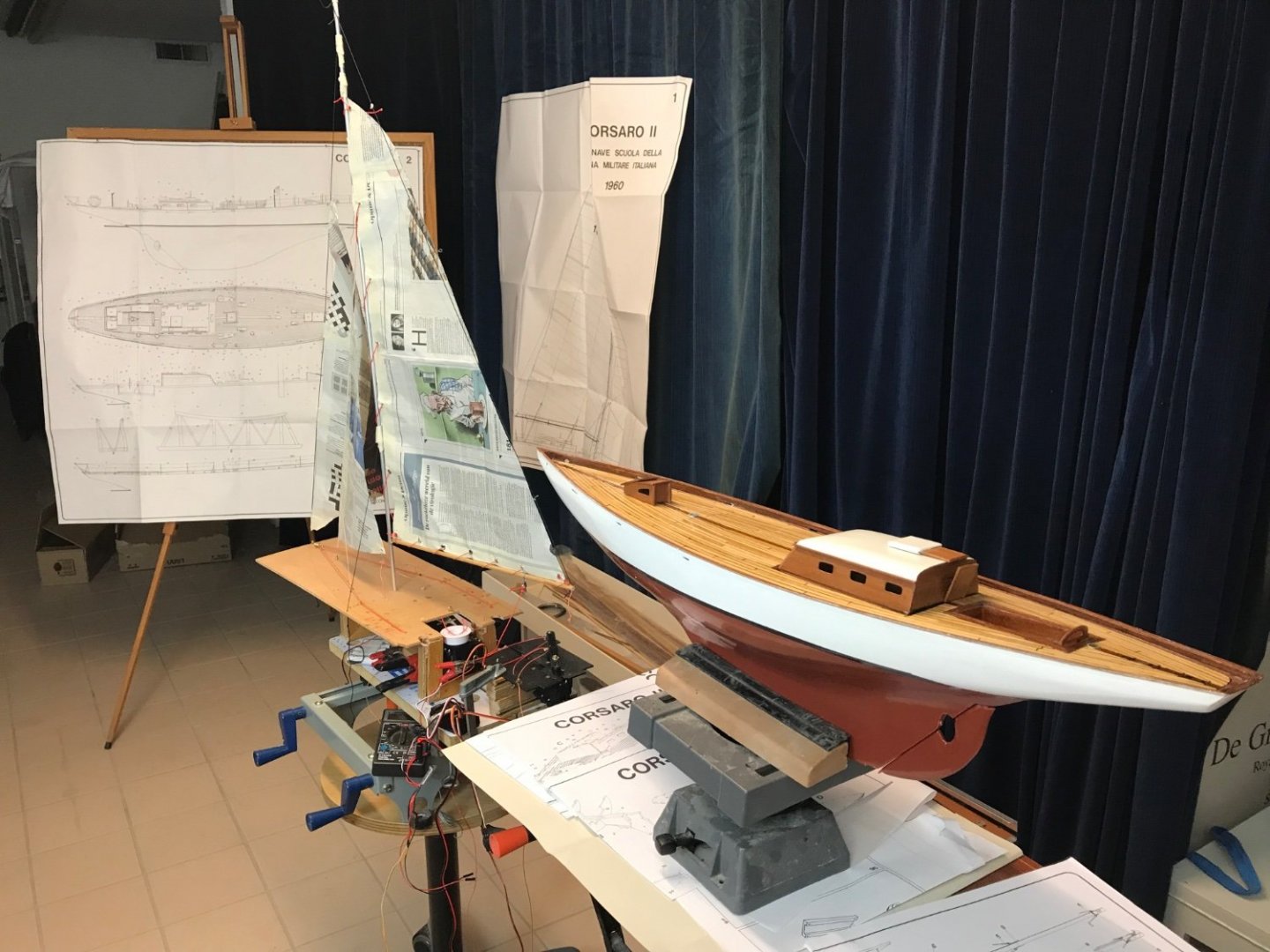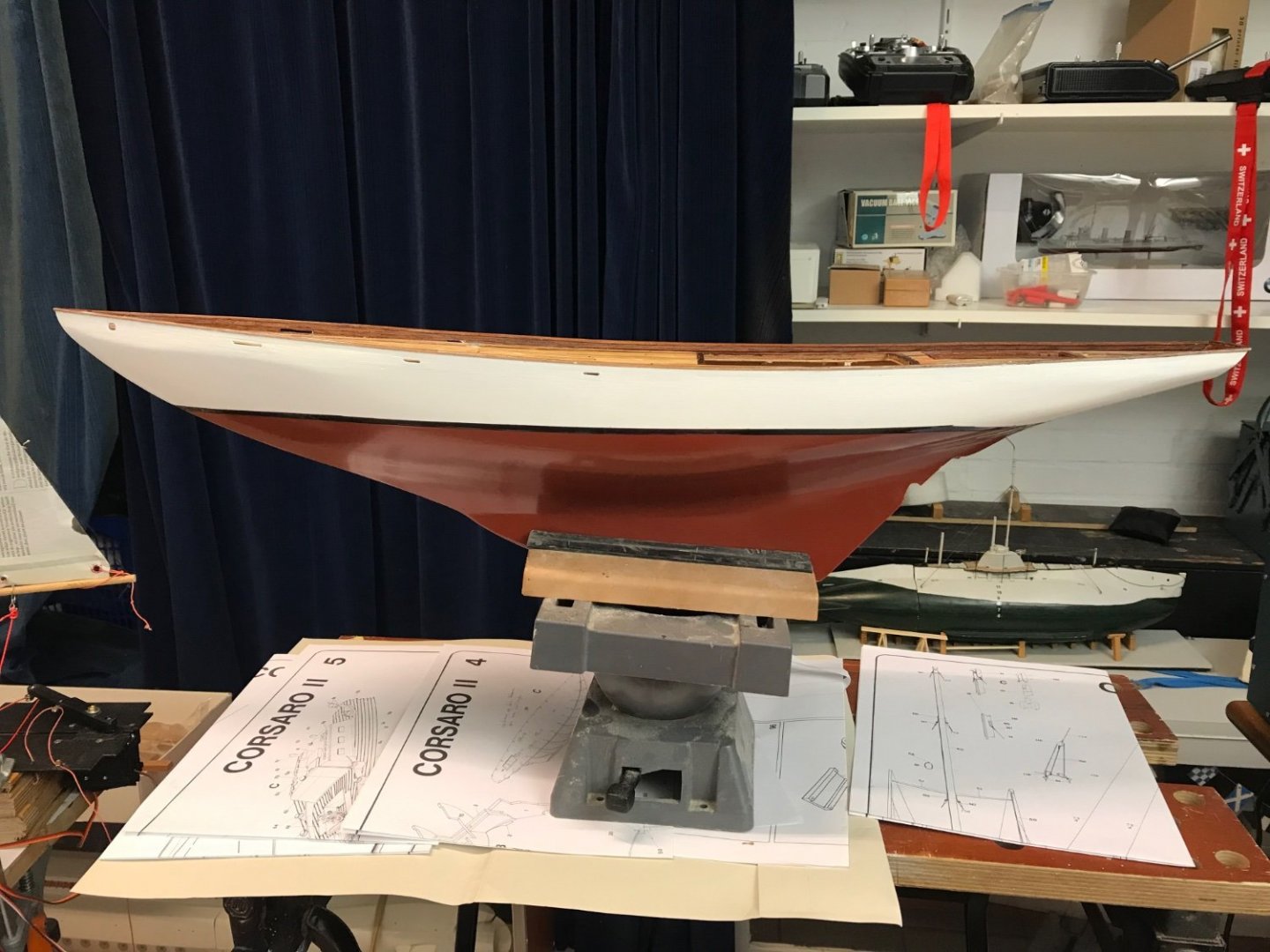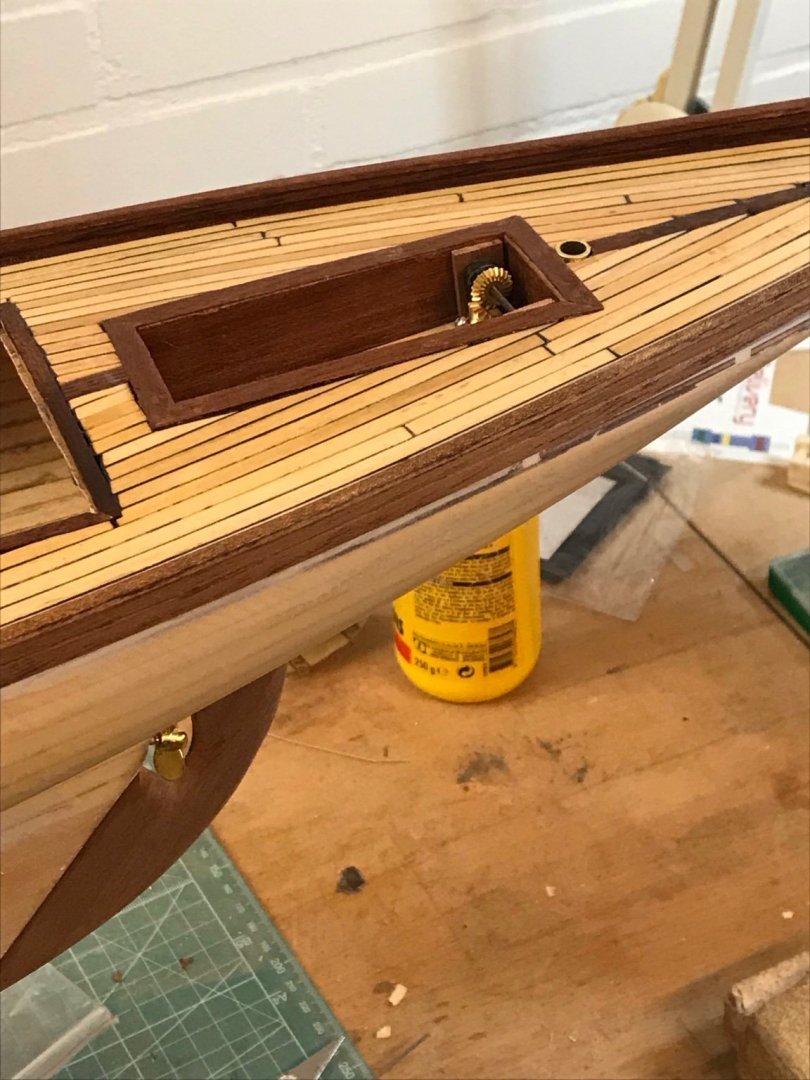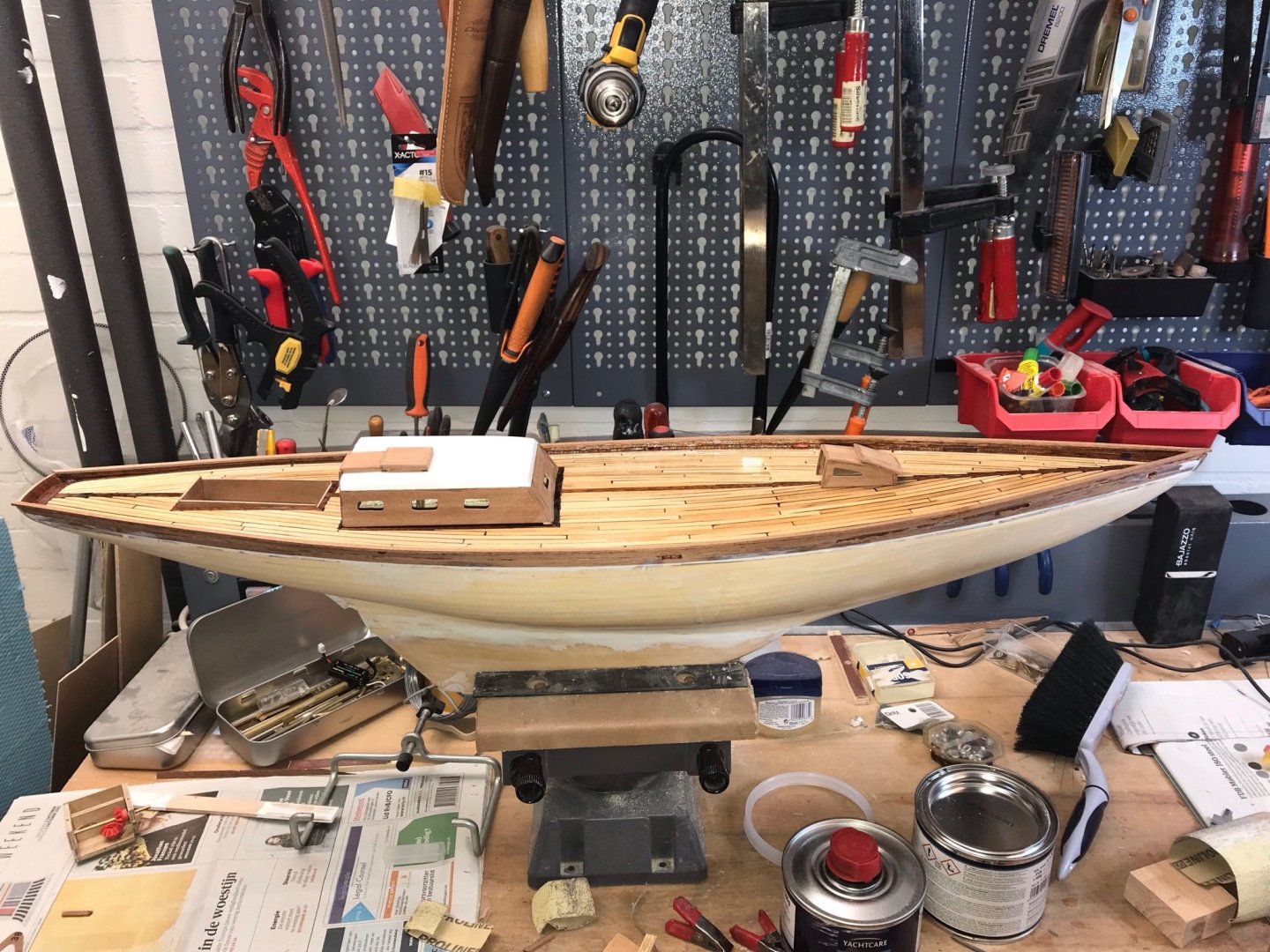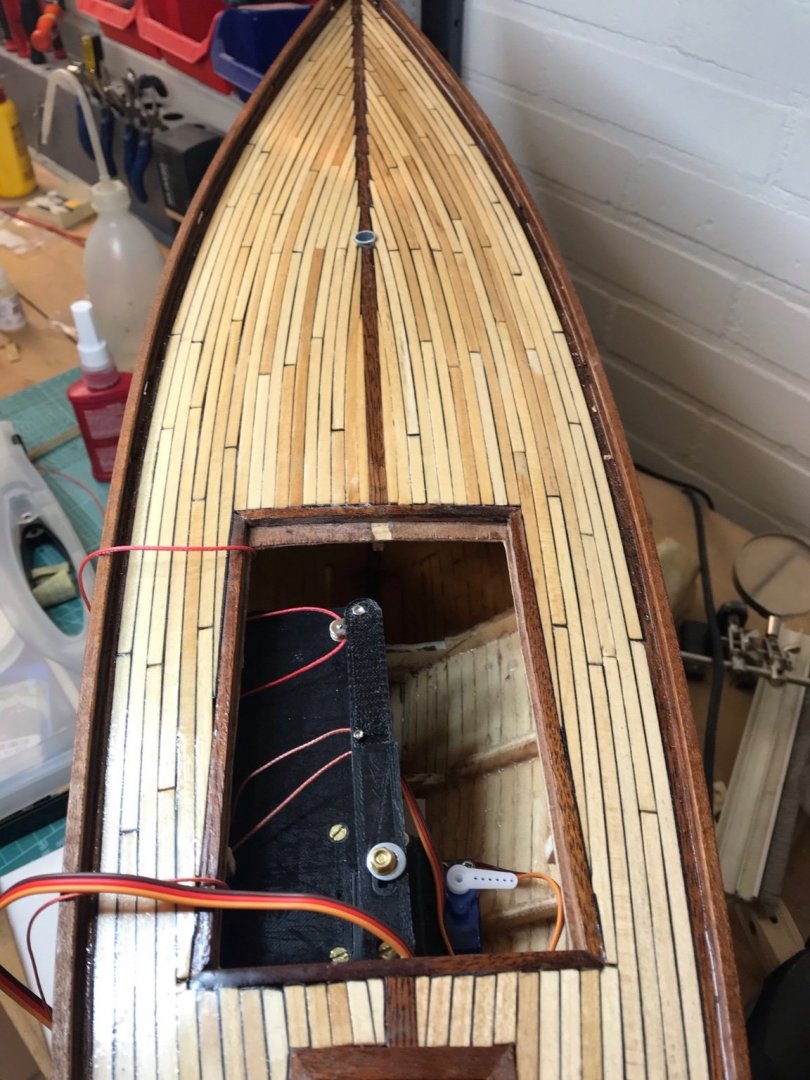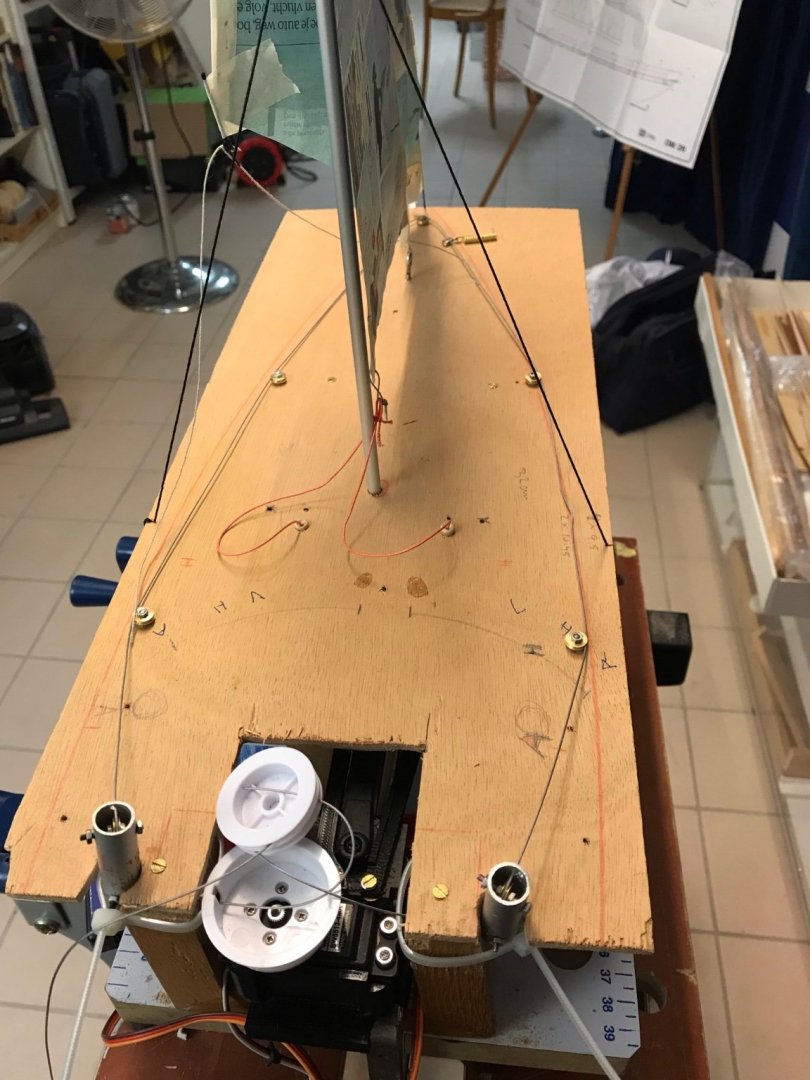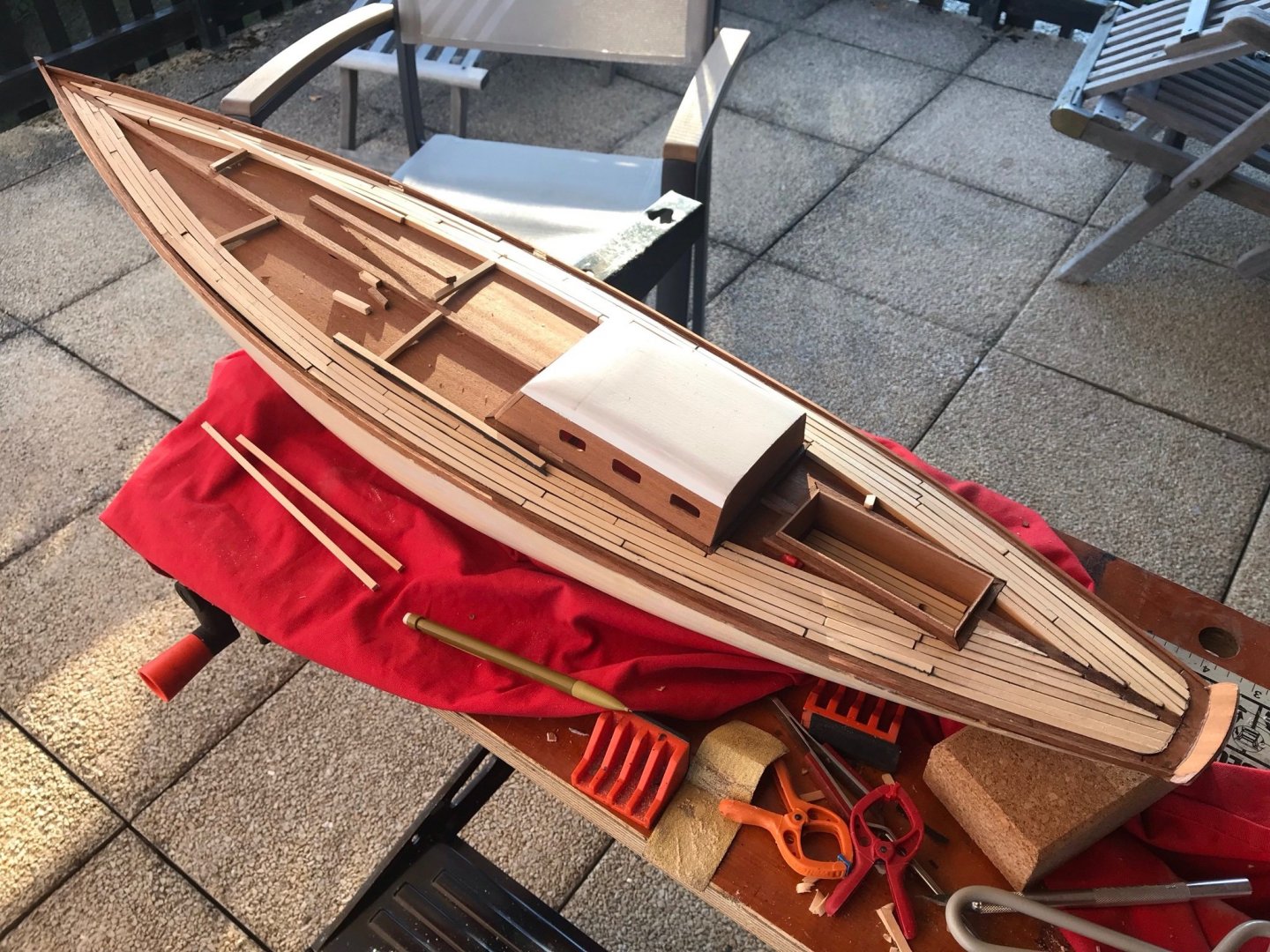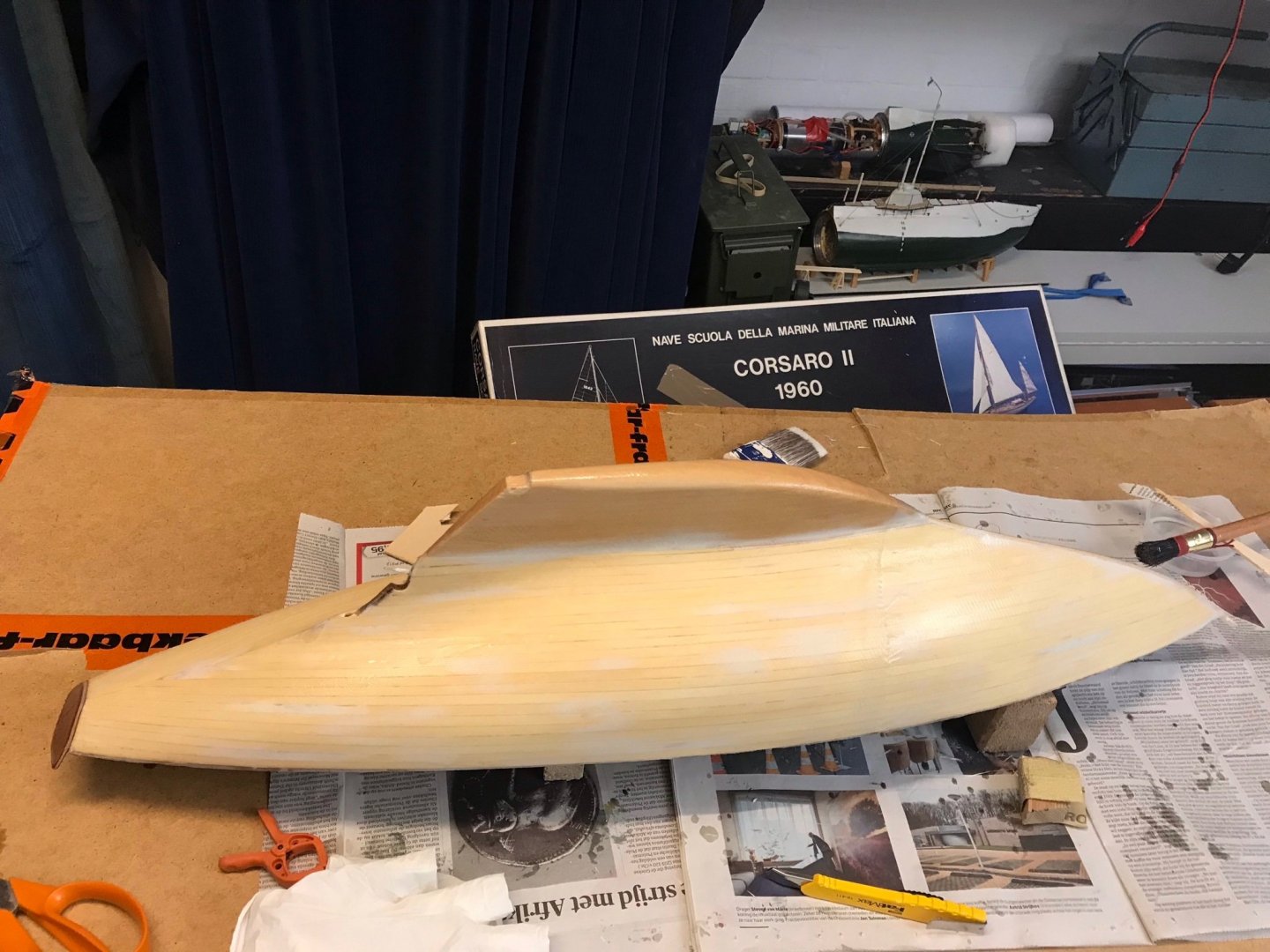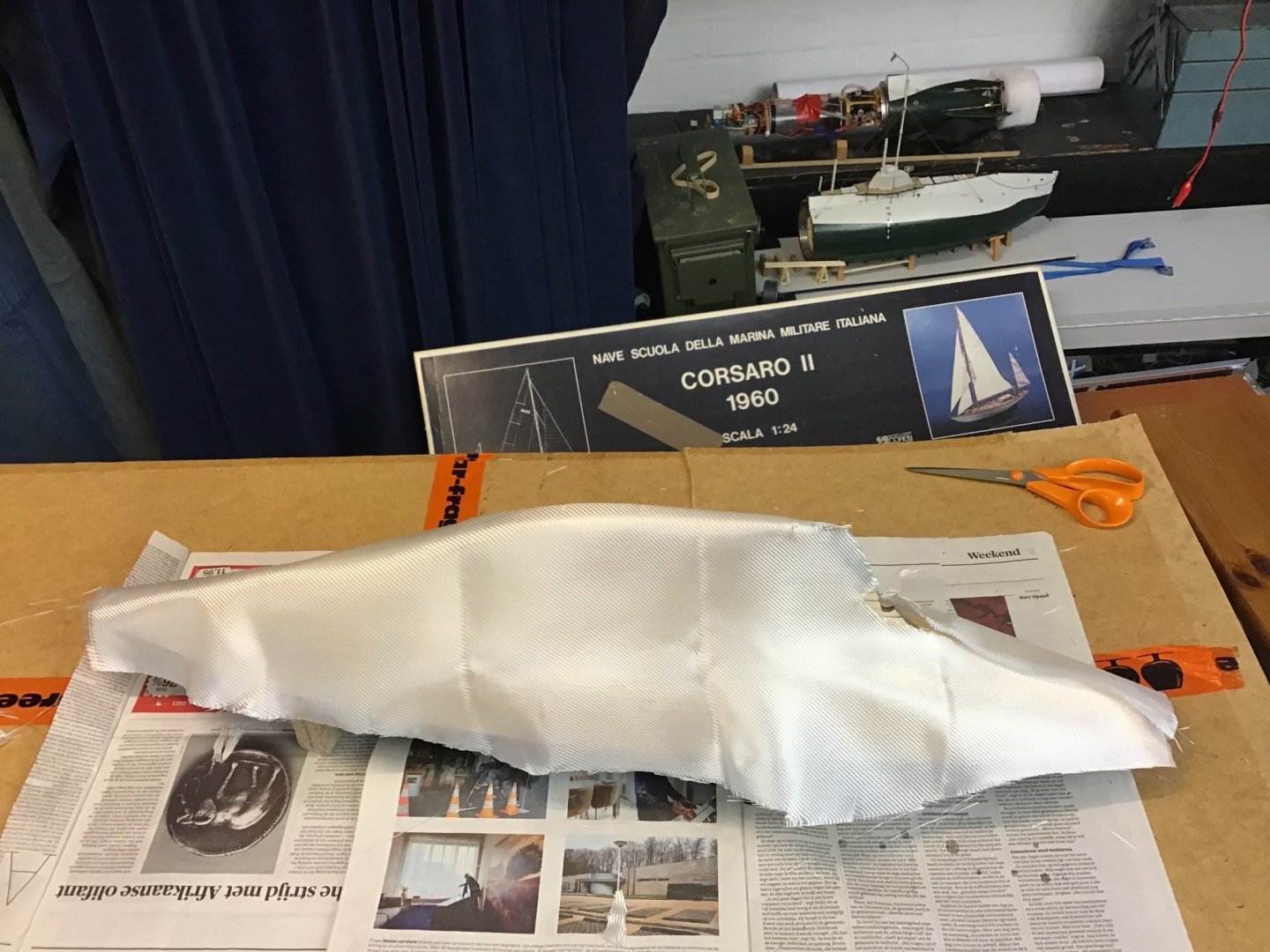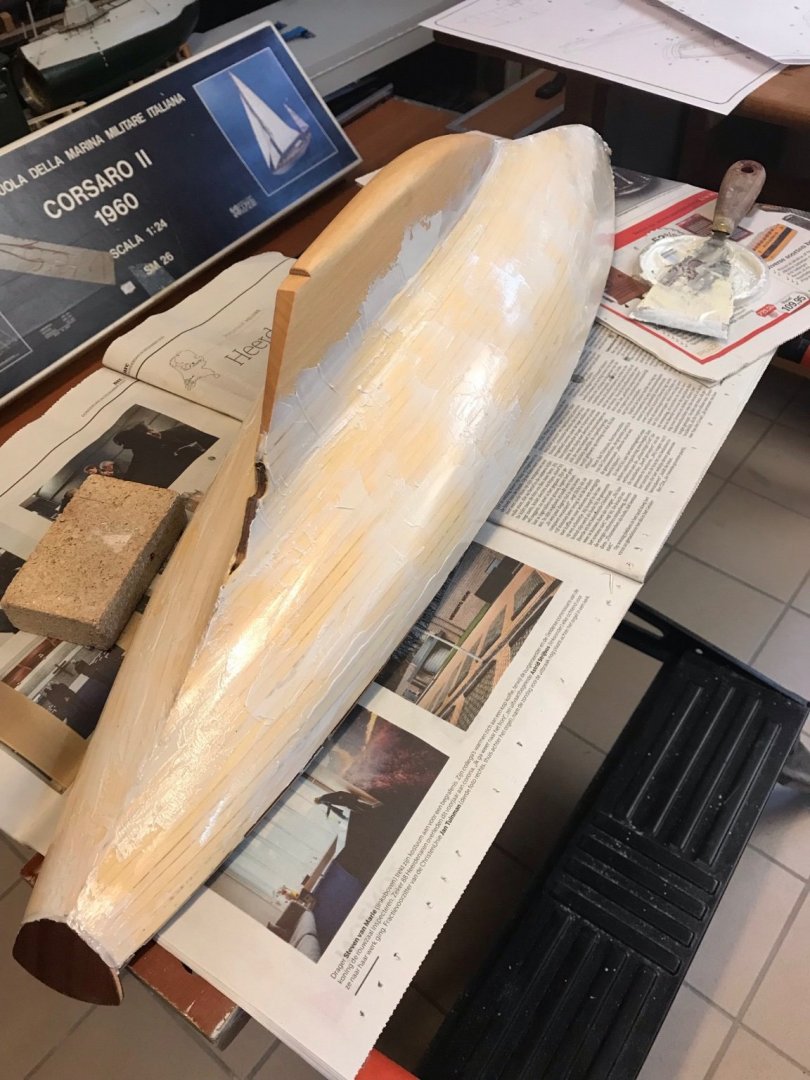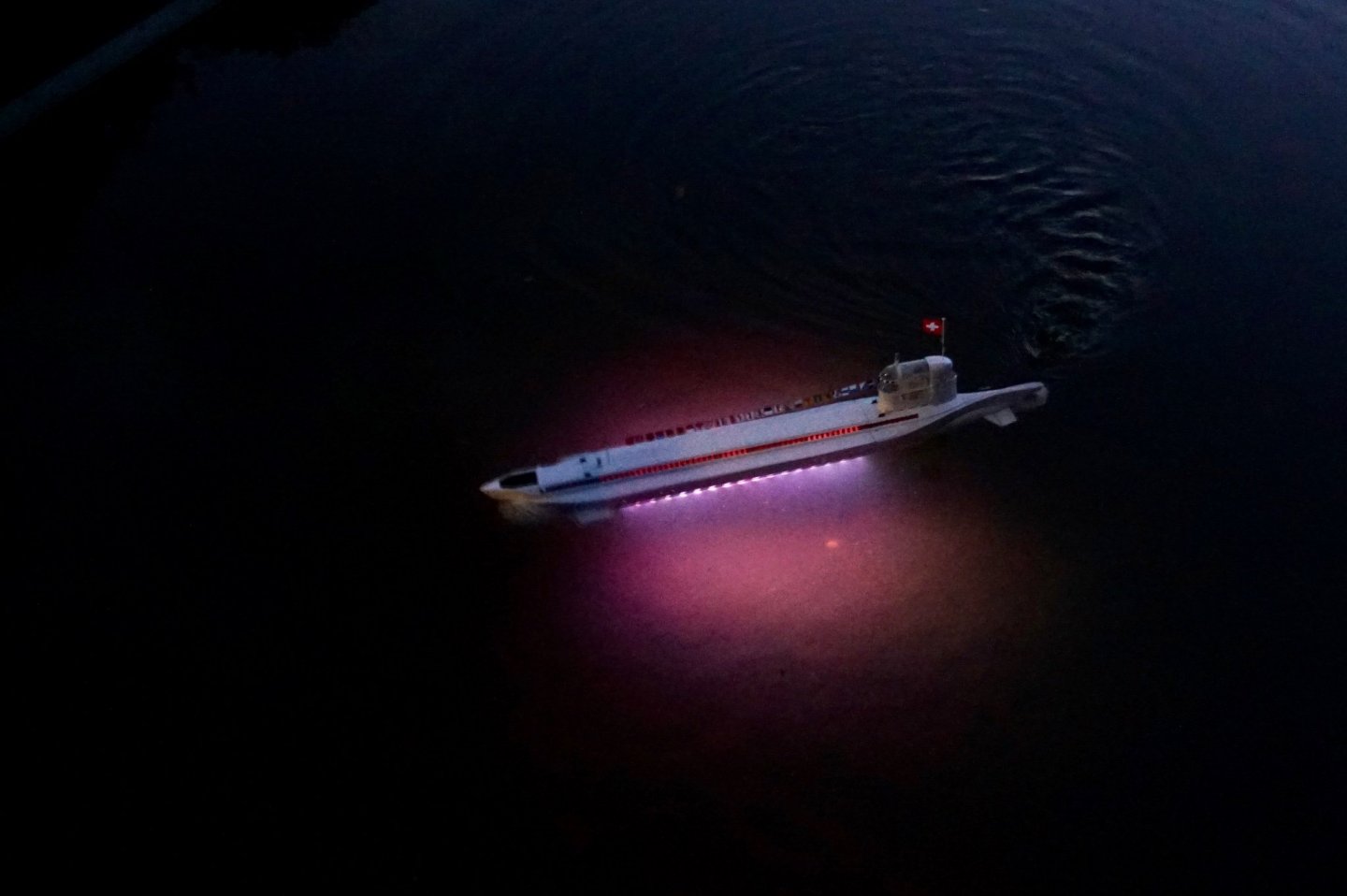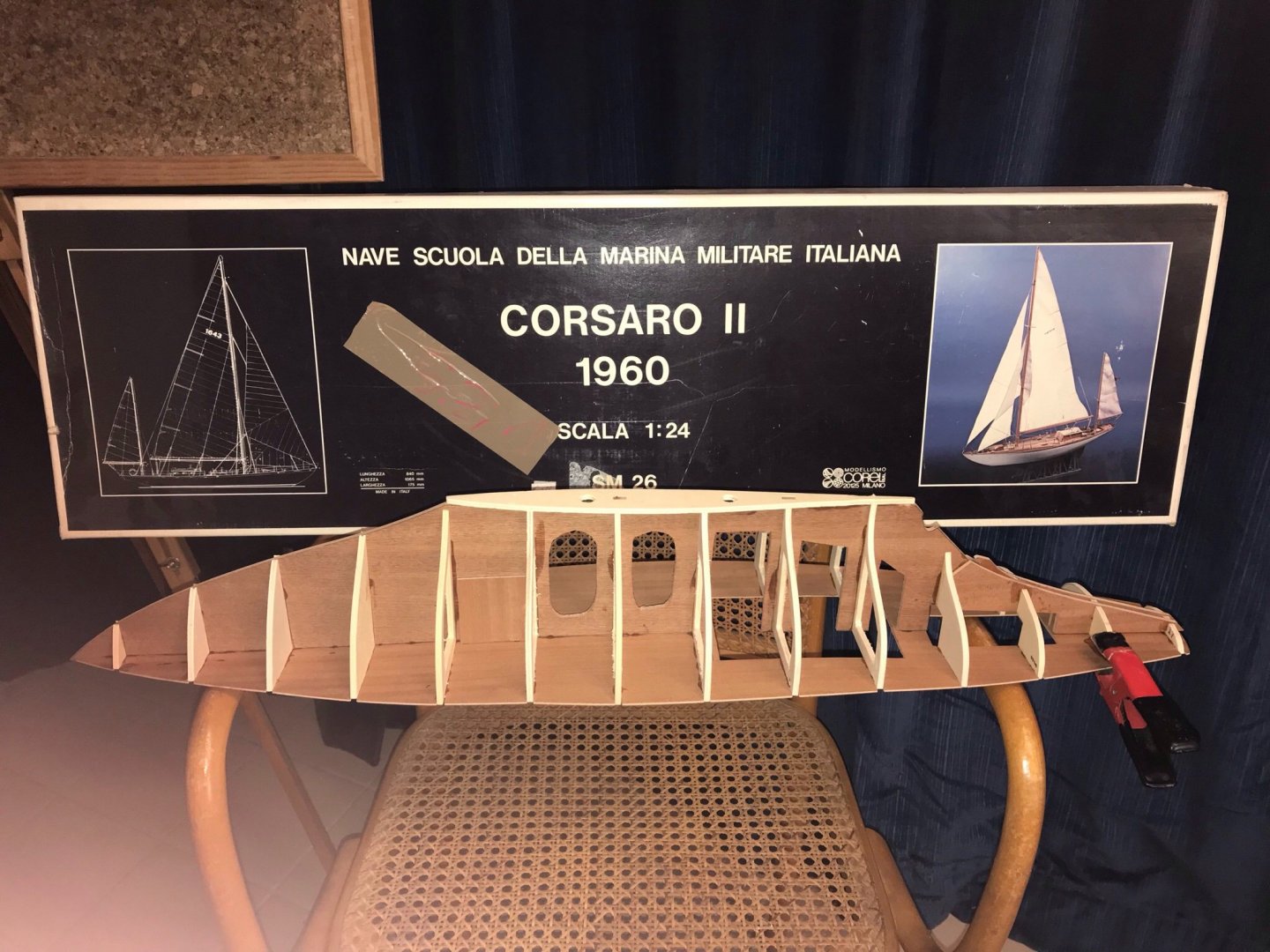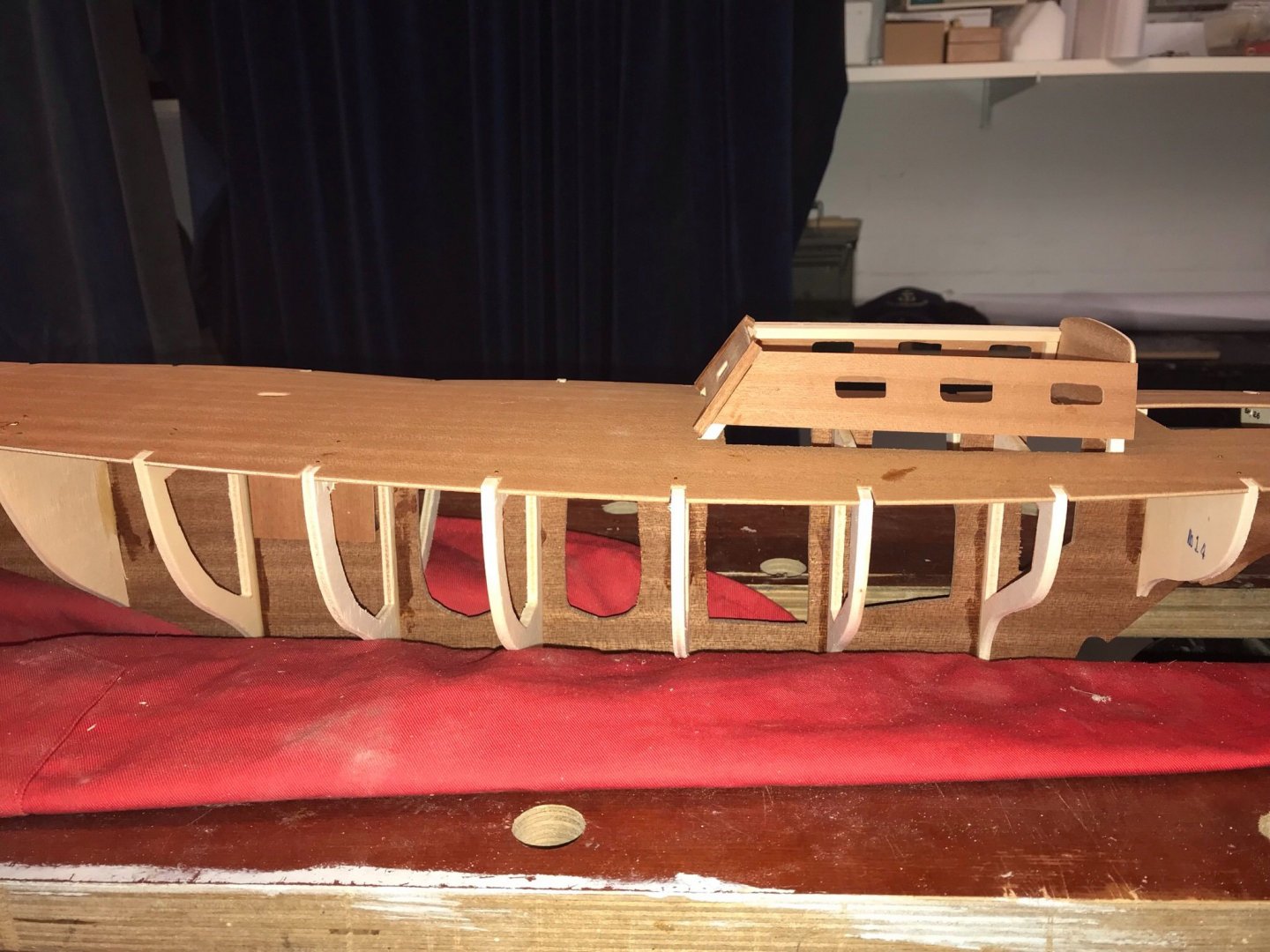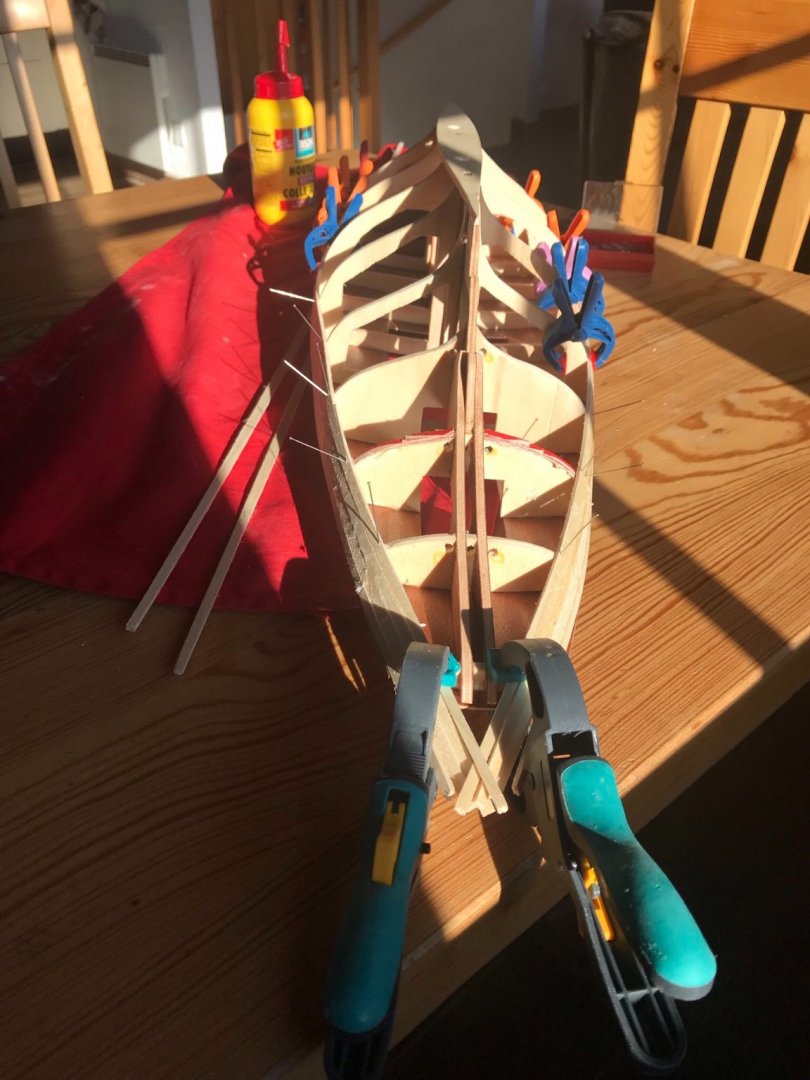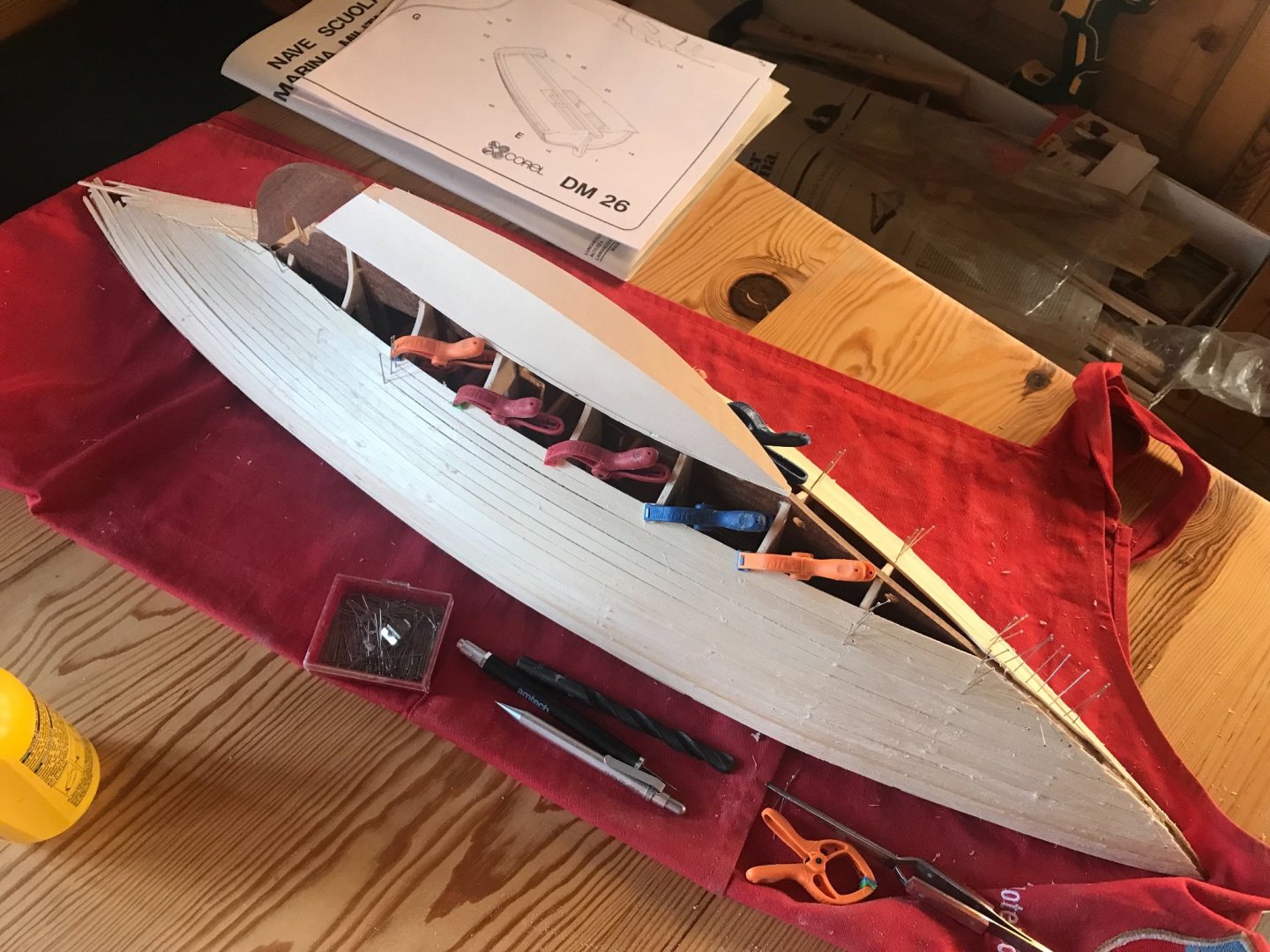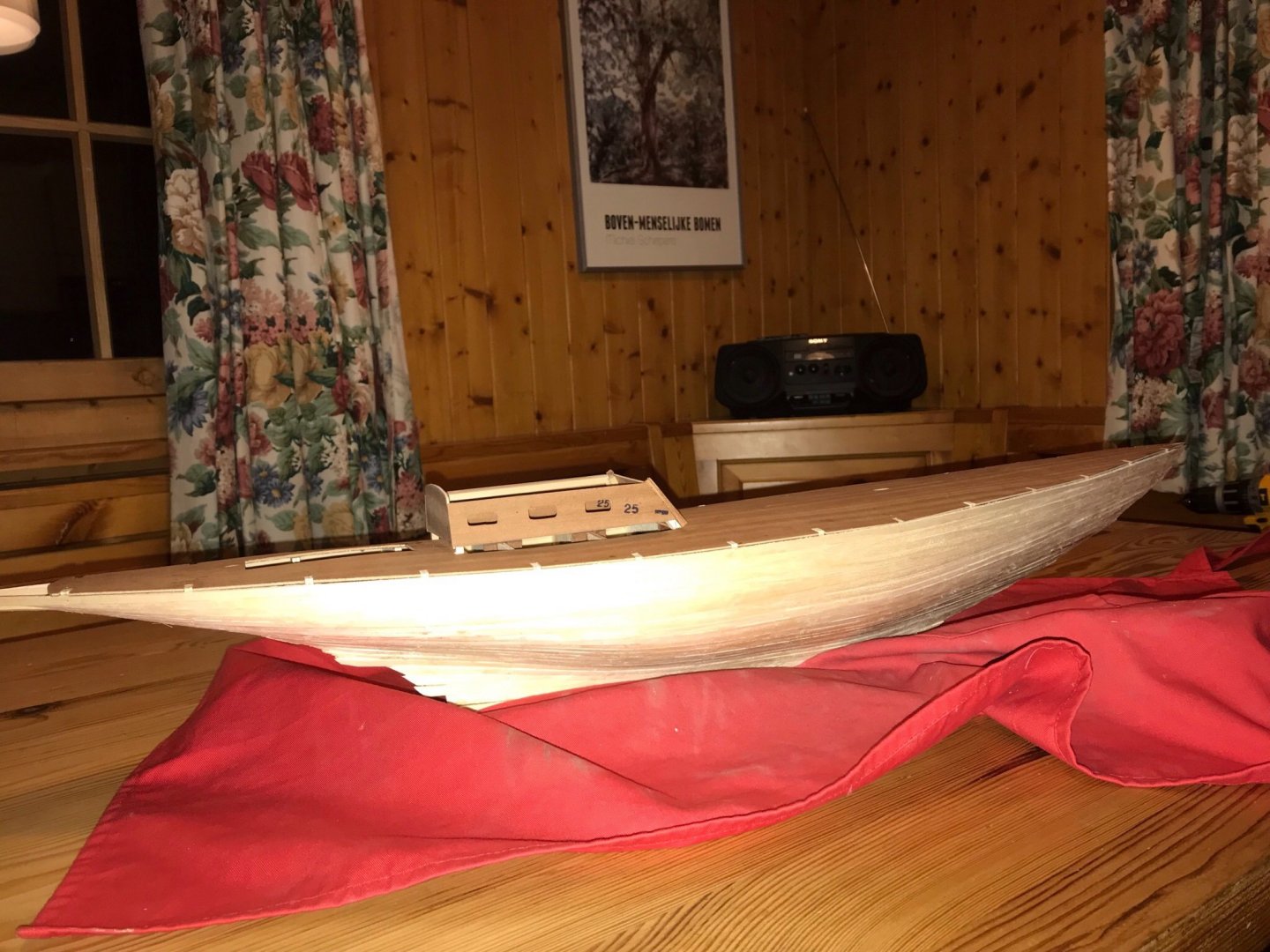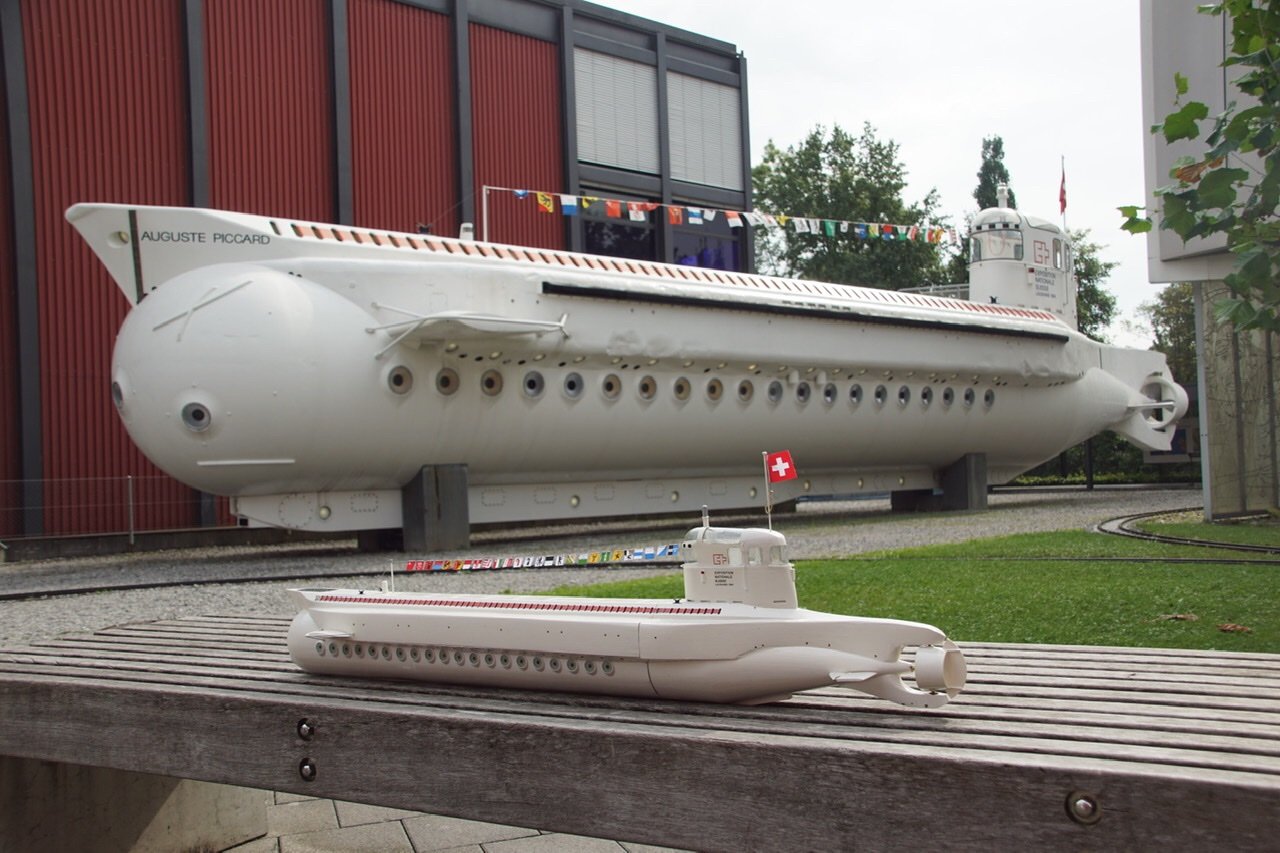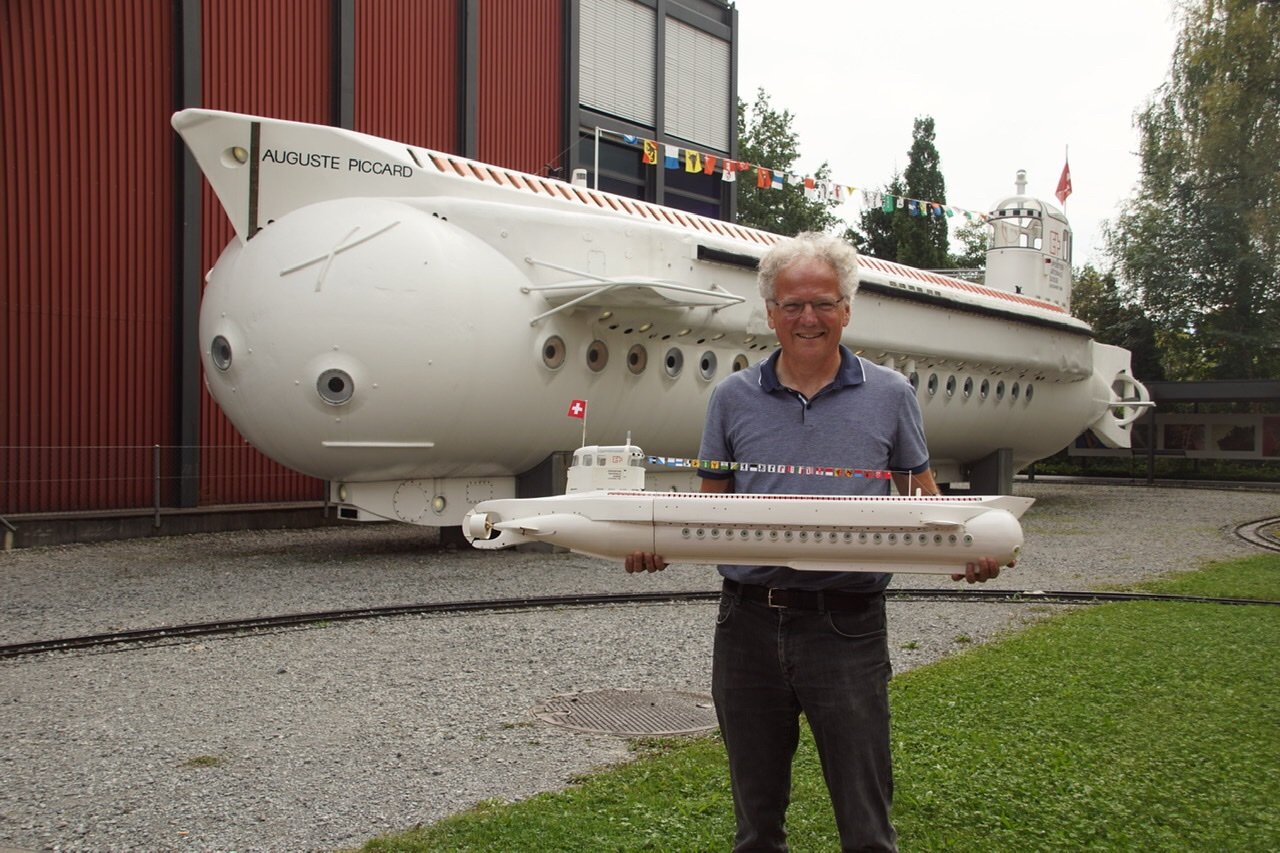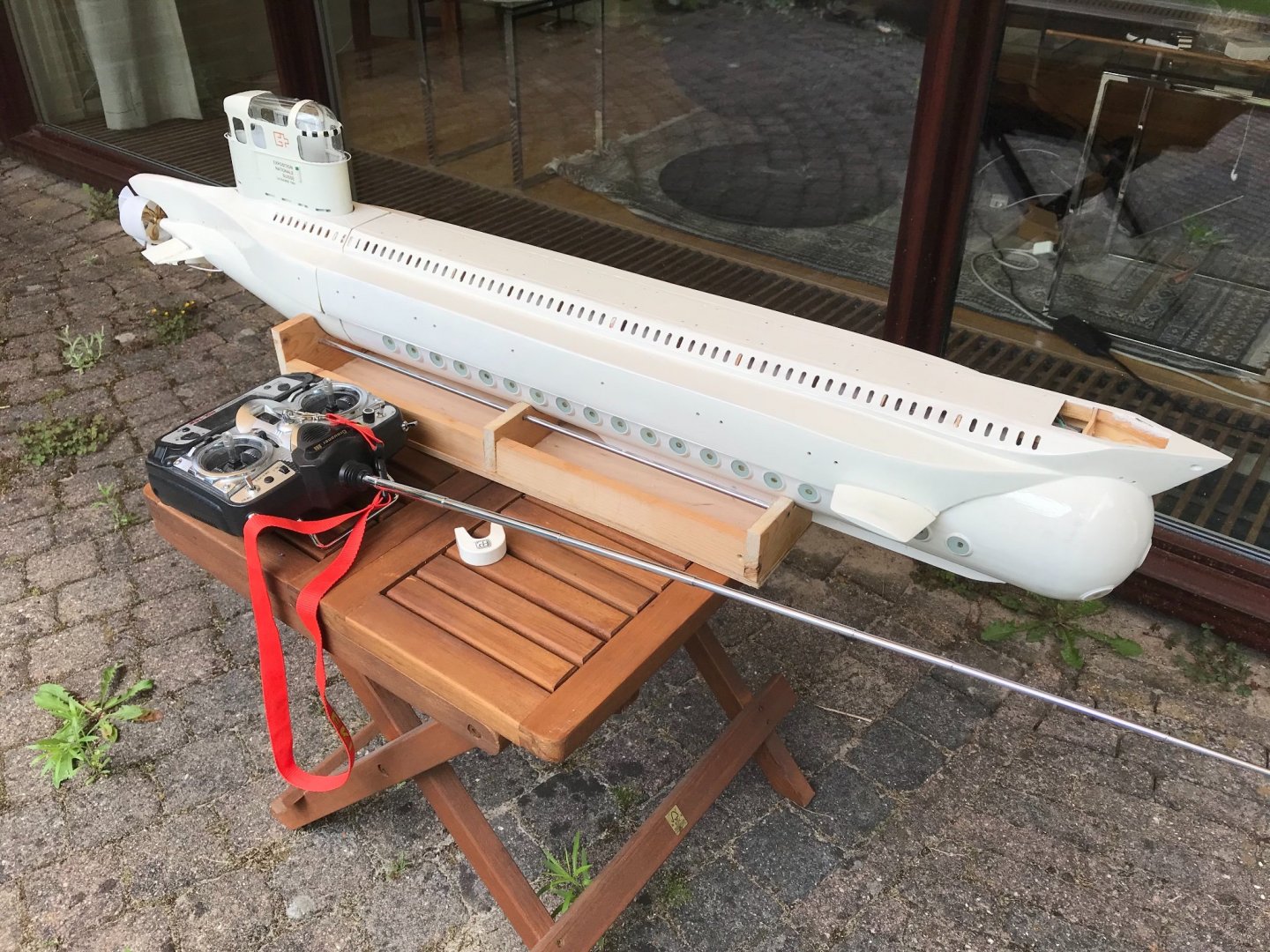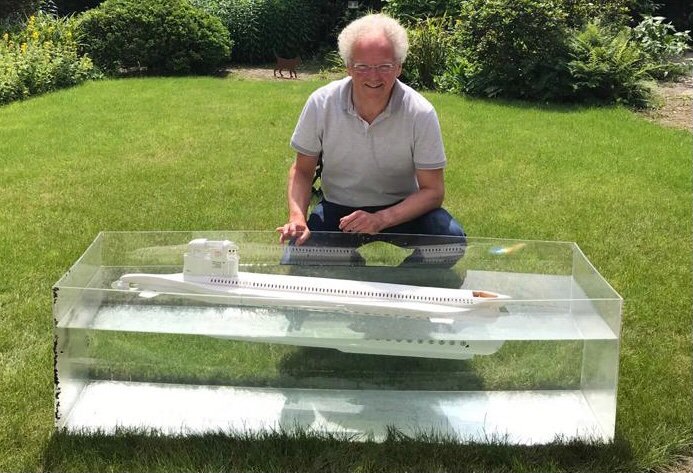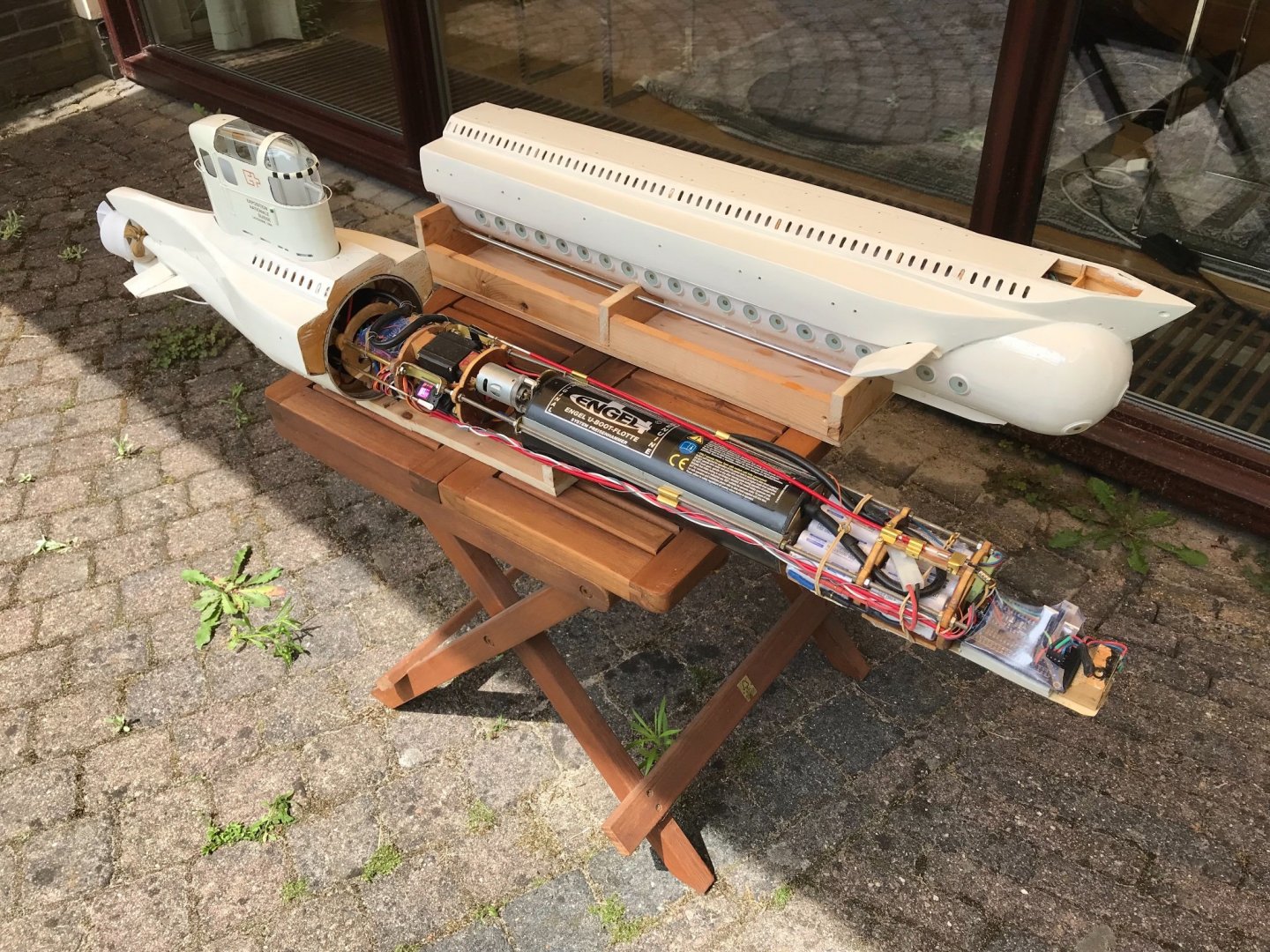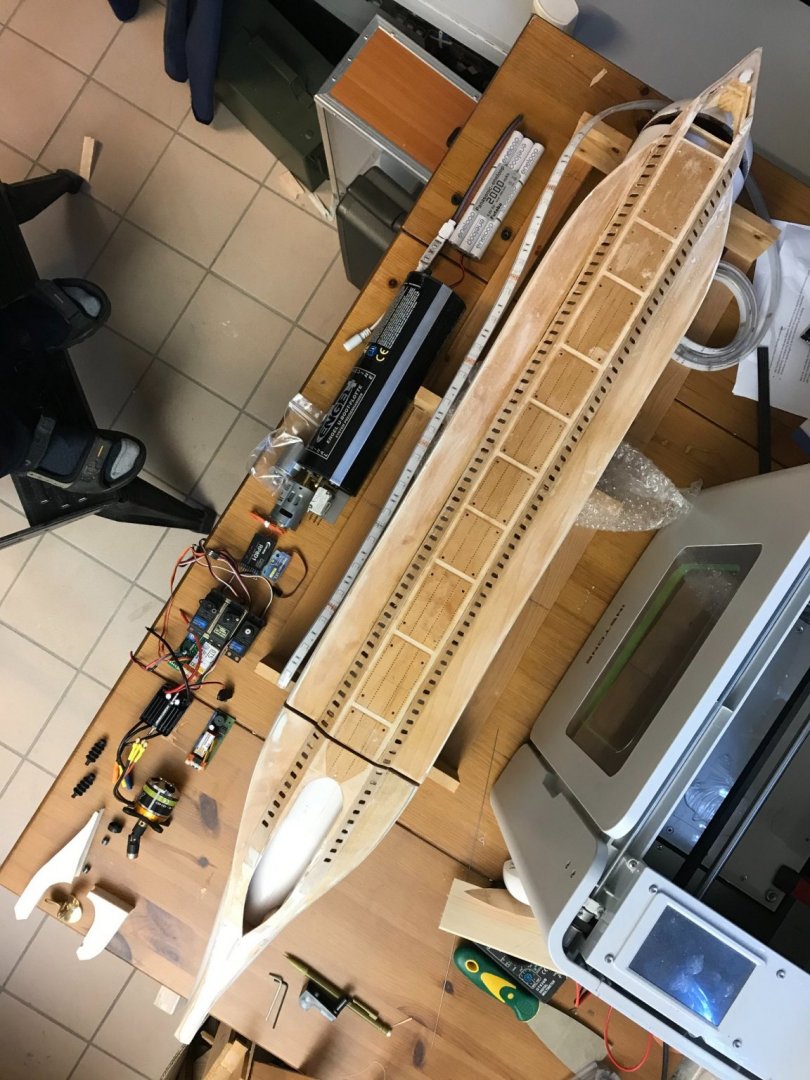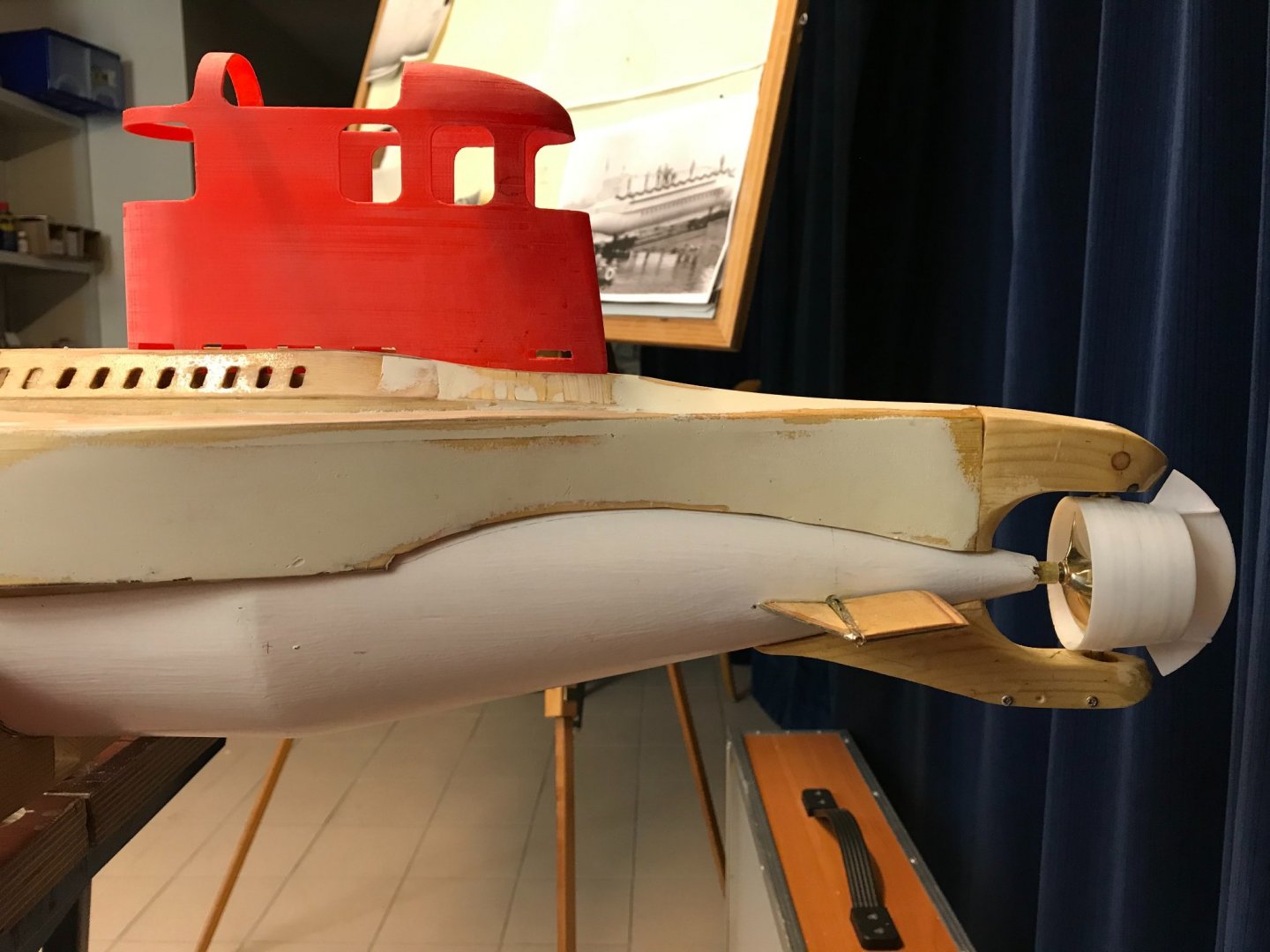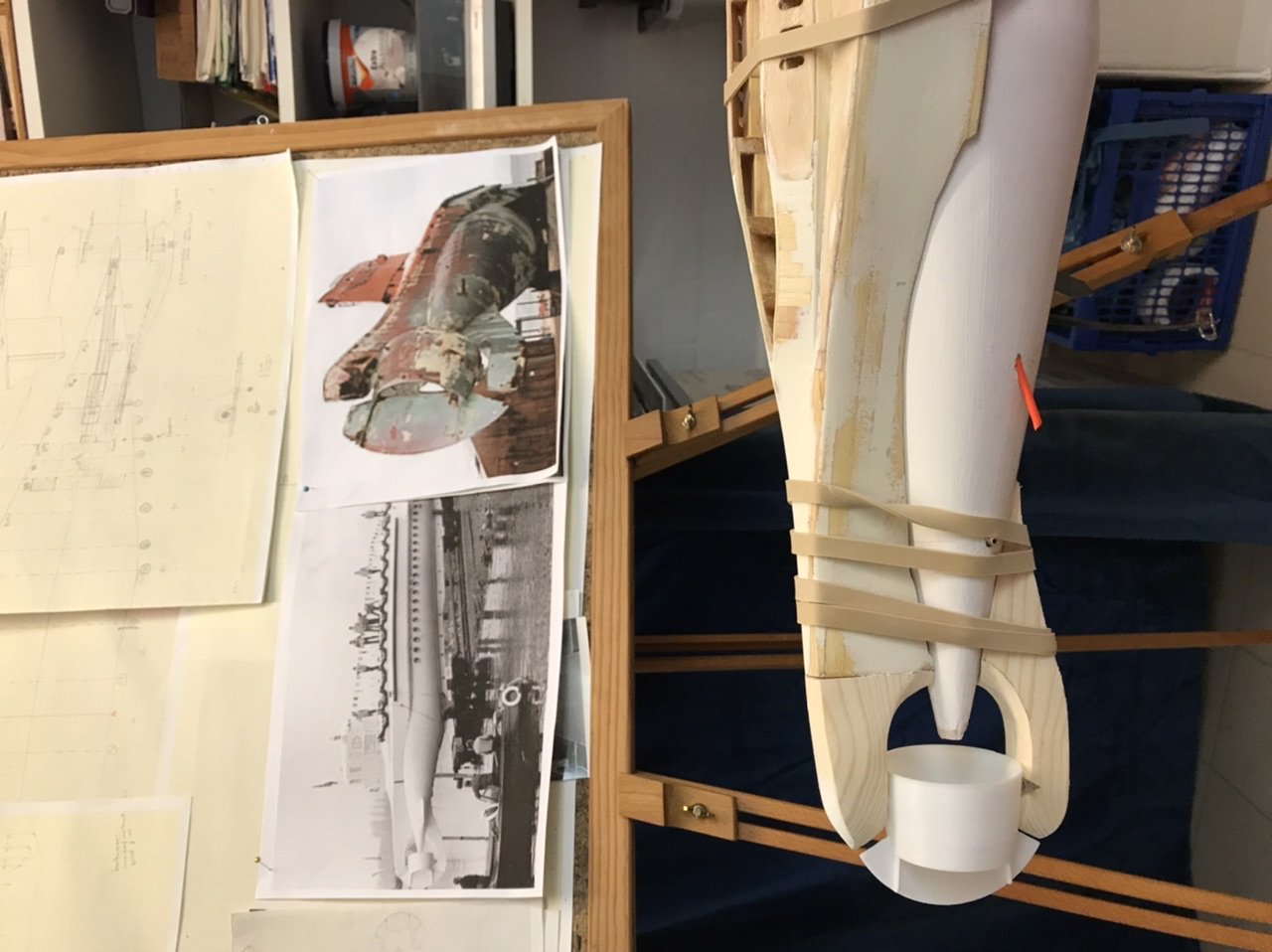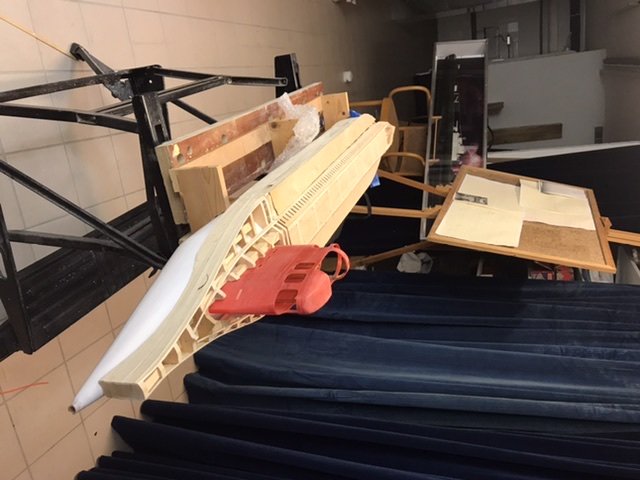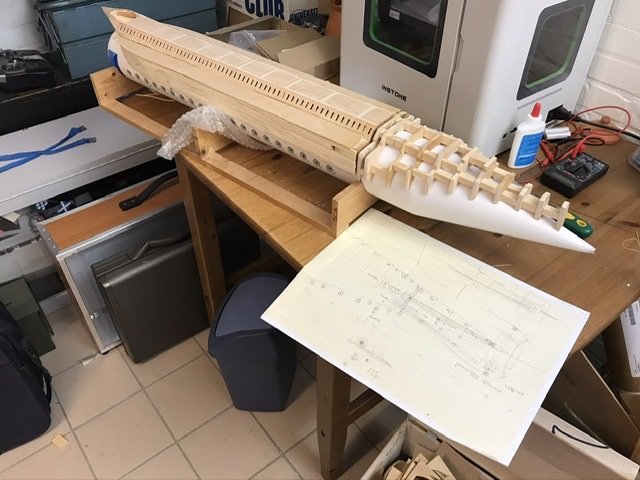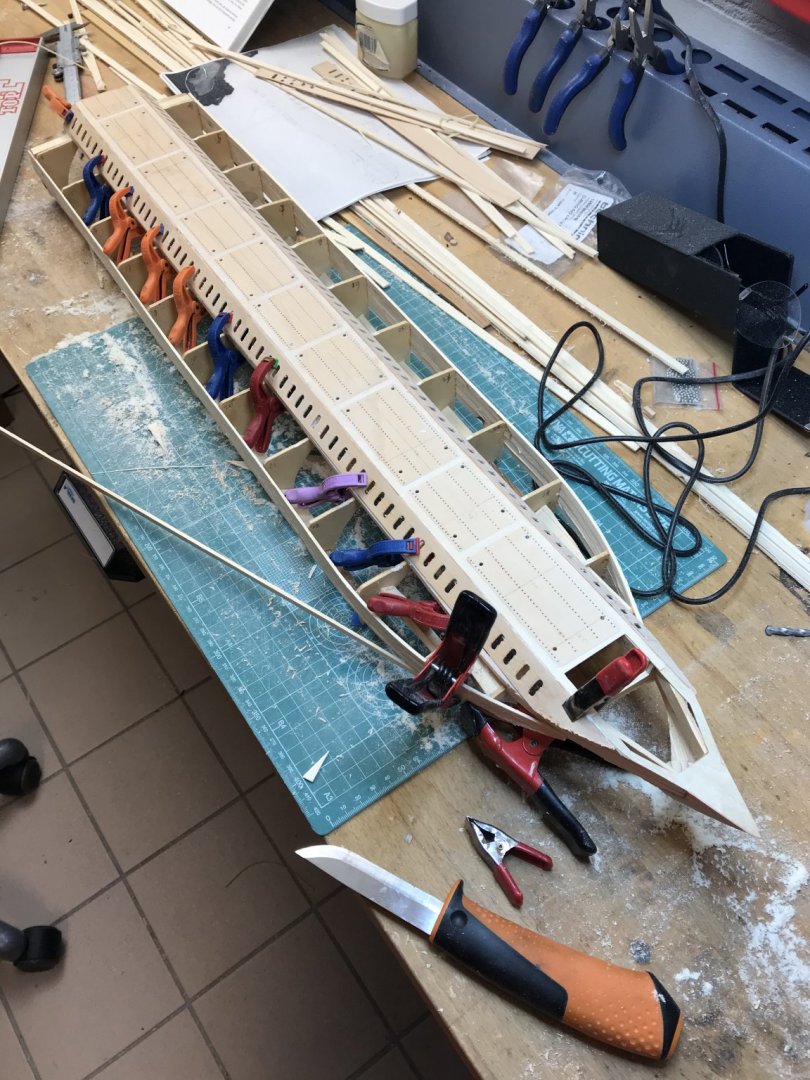-
Posts
215 -
Joined
-
Last visited
Content Type
Profiles
Forums
Gallery
Events
Everything posted by FreekS
-
Now, where was I? oh yes, sail making. the mainsail came out reasonably well for a first time user of the showing machine (might be too much tension on the thread in the sowing machine). Played around with a fan in my workshop to set the sheet lengths and servo settings on the transmitter. Then brought it to my model sailing club for a first spin - at sunset and in near windless conditions. When she did catch a breeze she moved quickly and heeled a bit. Next attempt was in a quiet arm of a local river in similar light conditions. Pics taken from a movie so resolution is not well. As usual need to do some repairs but I’m reasonably happy. Cleaning the hull is also needed! I think I’m going to consider Corsaro-2 finished - apart from testing with more wind and the consequences that may have. I deepen the bulb for stability for example.
-
It’s a sheet from Amati - meant for sails.it’s clearly woven polyester, I cut it with a hot soldering iron and the edges melt nicely.
-
I decided to start making some sails. Sailboats need sails, but also I have a worry that on this “kit turned RC-boat” the loose hanging sheets may tangle in the deck details (stancions, anchorwinch, air intakes, …). Those that are potentially in the way of the sheets are made, painted but only “dry fitted”. So now sails are needed to see what details can be on the boat and which need to stay in the box. im making sails with 1-4 panels, which are taped together to obtain a curve in the sail. Never done it before so no doubt will have to be repeated. mainsail is in progress with 4 panels. Flying jib is mounted and has 2 panels and for the bezaan I stuck to just one. we’ve had a week of gale force winds in the Netherlands and I’m happy to report ….. (not).
-
Hi Ian, I used metal shears which are great for cutting messing and other metals. Then just hammer the lead pieces flat. Once I know the amount is OK I will glue them to protect against moisture
-
Hi all, thanks for the likes and comments on my project - it’s getting interesting now as the kit contains many nice details, but these add weight on top as well as provide the chance for the sheets to tangle while sailing. First test in a bath showed that the boat is watertight, but very unstable. There was of course no ballast in the keel and the motors and battery, while at the lowest point, don’t counterbalance the masts. I had counted with this, and the keel contains 2 M4 threads to provide the boat with a n extra build keel. I printed the keel and filled it with 1.2 kg of lead (the boat is 1.8kg). The bulb is mounted 30 cm under the waterline and the boat is reasonably stable - I had to add another 165gram lead forward of the main mast to bring the boat level and on the waterline. We will see what happens with sails and wind….
-
Hi Ian . I thought about a drain for the cockpit. I can still do that but decided to wait and see how she sails. I use a drum winch (5 turns of a 30 mm drum) for the flying jib, and a servo with 10 cm arm for the mainsail.
-
Hello all, an update on my radio controlled sailing Yawl. The controls have all been built into the boat, and the transmitter set up to control rudder, jib/flying jib and mainsail/bezaan, as well as (in emergencies) the motor. as it’s an Italian vessel, I glued an Italian euro to the keel for luck. The sheets pass through the hull hidden inside brass winches, and today I mounted all the standing rigging - a fun job. The kit is equipped with two sizes of functioning turnbuckles (well after more than a decade in storage they needed some oil), and the shrouds come in three thicknesses. I mounted everything that I think will not get in the way of the moving booms, sails and sheets. Still a lot to do - stanchions, some smaller hatches and air inlets etc. Main future job will be making sails and a lead bulb keel. here is what she looks like today. There is a winter post-COVID meet of my model club this weekend and it’s soooo tempting, even without keel ballast and sails!
-
the Netherlands are the only country in Europe with a lockdown (recently somewhat relaxed) so lots of time for modeling! I’ve worked on the two masts- the kit comes with wood at make them from but to get some rigidity and since I dont really know how strong the wood is (after an unknown number of decades since the kit was produced), I’ve replaced them with carbon tubing, and messing pieces to attach the rigging to. All the different mast elements and the zalingen were glued and the two masts should be ready tomorrow. The rudder is now connected to its servo via two conical gears and a short bowden cable. The helmsman’s bench hides the gears and can be removed if I need to change the gears. The location of all servos is fixed, and are built into two 3D printed mounts underneath the cabin. The cabin is detachable aftersliding the hatch door sideways, and has obtained a simple seal to keep water out. The electrical system was still missing, so I made a sketch how the RC system will work. Power will be supplied by a battery ( 5x eneloop) near the main mast, and I’ve foreseen in a mains-switch, a charging cable, and a transformer so battery can be changed in future. ive started soldering the cabling, getting close to a first weigh-in. The boat should be around 3,4kg (fully loaded) and I hope most of that can be in a lead bulb/false keel, to be used only when sailing.
-
Painting the hull with white hull, red (darkened ral 3016) underwatership and a black waterline. Needs some touching up. Some of the deckhouses are being painted and finished as well. Mainsail and jibs now work well on the testrig. A prop was 3D printed and the motor fits as well. I’ve got Carbon tubing for masts - and start working on standing rigging - I hope to do that in a way that the masts can easily be removed for transport. making a sailing model from a kit does require lots of modifications!
-
Over the last months I’ve worked mainly on the technology. The deck is finished and coated with epoxy. It looks nice but could have been better… the outside still needs painting. Never built an rc sailboat before and so there is a lot of testing. First the rudder, the rudder “shaft” comes up under 45 degrees angle, and after many sketches I used two conical gears located under the helmsman’s bench to be able to connect that to a servo via a bowden cable. Tested but then removed again. also a shaft was drilled for the prop axle - it will be a 1mm axle, leading to a small motor I had lying around. for the mainsail and mizzenmast sails will be controlled by one servo with a long arm, the sheet is “doubled up” to provide enough length, and would normally be in the left side position, traversing to the right to sail “into the wind”. Hope the servo is strong enough, ….. main problem seems to be the two jibs, which will need relatively high sheeting length -especially the front one that needs to be pulled forward of the second jib to tack. Found some nice concepts on-line which I’m trying to realize with a “sephamore” servo pushing two arms, and a sail winch powering an above-deck circular line for the forward jib. These I’ve built a test rig to test the 3D printed arms for the servo. Generally I’m having too much friction. So regularly going back to the drawing board, this boat is just like a submarine with very limited space and severe weight constraints! and I just burnt the sail winch. Not a great confidence builder….
-
While the hull needs another layer of epoxy, I took the boat on holiday and worked on the deck planking. The “kings plank”, deckhouse and well are hardwood, and then 4x4 mm white wood are used to plank the hull. I interspace the planks with 0,3mm black carton (hope it sands well later,….). It’s a lot of work and will need a lot of sanding and finishing later, but a fun job.
-
After planking of the hull, the wooden keel has been shaped and glued to the hull. The first sanding, coating with epoxy resin, and using epoxy putty to smoothen the hull has been done. The whole was sanded with 100 grid sandpaper, before applying a second coat of epoxy resin and a 160g/m2 glass-fabricagerekening, followed by another epoxy layer. There are some air blisters under the glass layer, and there is some visible overlap in places. I think with more sanding and epoxy putty I should get that fixed. I’ve actually only made a hull this way once, and that was my submarine O-1. The cigar shape of that hull made the glass fabric stage easier to do.
-
yes my testing also was in a shallow lake, and while submerged - a large “smoke-trail” was following the model as it scraped through the mud. Not good for the nerves! Here’s the boat in that same lake at dusk - good to see the effect of the LED strips I spent so much time waterproofing and building an arduino controller for! thanks for all the likes!
- 55 replies
-
- auguste piccard
- submarine
-
(and 2 more)
Tagged with:
-
Hi all, After completion of my submarine Auguste Piccard, I started on my long delayed Corsaro 2. I bought the kit about 12 years ago from a model shop that went out of business. Price on the box is 288 UKP, but I bought it in Holland for less. Looks complete but someone made some pencil scribbles in the manual before returning it. I intend to make it radio-controlled. Never built a sailboat before but I understand I will need to build light (I.e. take weight out of the hull where possible), likely need a deep add-on keel with lead bulb, enlarged rudder, and much more I don’t know about yet. Started sawing out the insides of most of the frames and the keel”plate”, before mounting the frames. One of the difficulties with this model is the curved deck needing to be glued to the frames right away. So access to the interior is very difficult. I cut out the deck under the deckhouse, and will make the deckhouse detachable. I did think of putting a first coat of varnish on the frames and keel before planking, and ensuring water coming into the hull can find its way to the lowest point. Then started planking the hull. The manual is short but highlights the important steps such as planing the frames and adjusting the width of the planks. also made sure I drilled out a cavity for the rudder-“axle”. The wooden keel and rudder seen here need work much later but I can mount a “sailing keel” on it later. Both are of course not attached yet. so after about a week the hull has a first planking. Instead of the second planking, I intend to sand - epoxy - putty - and cover the hull with glass-fabric and epoxy. That requires some time, stuff to be ordered, and anyway, the holiday is over. Later more. All suggestions of course welcome!
-
Today the model made its first foreign visit, to the “verkehrshaus der Schweiz”, the transport Museum of Switserland in Luzern. There the museum allowed me to photograph the boat with its namesake and even sail and dive in their boat basin. Very nice - the boat is not yet fully finished, name and others decals I made are not mounted yet (I need to find a clear coat that does not yellow when over solvent based paint). More importantly, while the boat runs and turns very well on the surface, trimming underwater still needs some iterations of moving ballast. But today was a very nice day!
- 55 replies
-
- auguste piccard
- submarine
-
(and 2 more)
Tagged with:
-
thanks for the compliment! It’s an Engel pistontank - a 750ml piston driven by an electric motor. The piston draws water from outside, compressing the displaced air volume in the boat (which has to be airtight). Because of this overpressure in the boat one can rise by reversing the piston. Its often used in europe - though it’s the first time I use this - in my prior boat I used a two way peristaltic pump but that’s much slower and risks overfilling the tank if the sensor fails.https://engel-modellbau.eu/shop/en/Sub-Components/Piston-Tanks/
- 55 replies
-
- auguste piccard
- submarine
-
(and 2 more)
Tagged with:
-
Again 6 months went by, this time with significant work done. The waterproof LEDs were mounted as floodlights over the hull portholes, with waterproof connections through the hull and controlled by an Arduino nano. the boat was ballasted with nearly 3 kg of lead - decided over the keel, and deep in the hull in-between the ribs. the hull was painted again and the sail mounted, complete with windows and decals. then the boat was launched in my test tank, needed about 600 grams of extra ballast, moving ballast around a bit, and resolving some leaks through the propshaft, bowden cables etc. The epoxied hull itself was water- and airtight. first test in the tank meant filling the 750 ml divetank - thus creating overpressure in the hull (and now the leaks seem resolved - for now). The boat went up and down perfectly level, so very happy withete first tests! Still a lot to be done, especially on the rudder/prop shroud which has too much play, but I’m getting there!
- 55 replies
-
- auguste piccard
- submarine
-
(and 2 more)
Tagged with:
-
I've made quite a bit of progress since September - thanks to lockdown but unthanks to recent cold in the basement! The "Techrack" is fully built - with batteries, Engel "Kolbentank", Arduino controller for the tank built by a friend, brushless motor and controller, magnetic on/off switch, Corona (!) 40 MHz 8-channel receiver and three news servos. I'll do a video of it somewhat later the picture shows the incividual components. The propeller and shroud, diveplanes fore and aft and the tank all work well off my Futuba Mx-16 transmitter. Now working on the waterproof LED strip that will provide lights over the passenger windows. I've given up making drawings, it quicker to do the work twice! The shape is mainly there - though there is still an extensive keel section to be built. Windows in the 3D printed "sail" will also be a challenge! Just to prove the techrack is actually inside a short video. The joy one can have in simple things..... IMG_2130_HEVC.MOV
- 55 replies
-
- auguste piccard
- submarine
-
(and 2 more)
Tagged with:
-
That’s a great idea, everything is still loose and I’ll think how I can do that. I’m waiting for the prop shaft to arrive ..... Thanks!
- 55 replies
-
- auguste piccard
- submarine
-
(and 2 more)
Tagged with:
-
Started now on the more technical parts - from the stern forward. I decided to print the shroud/rudder combination, and it will be quite a challenge to mount and ensure the propellor aligns perfectly with it. I am waiting for parts of the drivetrain, so focused on making the supports for the shroud, and the stern dive planes which will be controlled via a Bowden cable visible. The second Bowden controlling the rudder will run through the lower wooden support part. Above the model a couple of fotos of the original at launch in early 1960s and and pre restoration around 2010.....
- 55 replies
-
- auguste piccard
- submarine
-
(and 2 more)
Tagged with:
-
Hi all, first layer of epoxy-putty is on, and I’ve laid out the equipment I’m going to have to install, and roughly where in the boat it will come. note the picture is a bit „wavy“ due to panorama mode....! from left to right battery pack placeholder, LED Controller for the strip of LEDs that will come above the windows, Engel Ballast Tank (basically large electric syringe to take water in and pump it out) 40 MHz receiver and electronic leveler three servos for rudder and front and rear diveplanes Ballast tank controller motor speed controller and magnetic on/off switch brushless motor with coupler to shaft Messing cast prop.
- 55 replies
-
- auguste piccard
- submarine
-
(and 2 more)
Tagged with:
-
Woodwork on the hull nearly finished - next is impregnating with thin epoxy resin, then applying thick epoxy and sanding. Oh well, only in year 5 or so. Freek
- 55 replies
-
- auguste piccard
- submarine
-
(and 2 more)
Tagged with:
-
Finally starting to look recognizable. The woodwork is slow, mainly because the drawings I constructed from photos are not always accurate. But I’m not unhappy with the rough shape. It will be tricky to align the front and rear sides, which are separated by a bayonet. But at least I’m in my basement while it’s 32C outside!
- 55 replies
-
- auguste piccard
- submarine
-
(and 2 more)
Tagged with:
-
Well, I’m building again! My other projects are finished and as there is little model ship sailing going on I don’t need much time for repairs! Been working on the deck section of the Mesocaph, which will fit on top of the cylindrical pressure hull.
- 55 replies
-
- auguste piccard
- submarine
-
(and 2 more)
Tagged with:
About us
Modelshipworld - Advancing Ship Modeling through Research
SSL Secured
Your security is important for us so this Website is SSL-Secured
NRG Mailing Address
Nautical Research Guild
237 South Lincoln Street
Westmont IL, 60559-1917
Model Ship World ® and the MSW logo are Registered Trademarks, and belong to the Nautical Research Guild (United States Patent and Trademark Office: No. 6,929,264 & No. 6,929,274, registered Dec. 20, 2022)
Helpful Links
About the NRG
If you enjoy building ship models that are historically accurate as well as beautiful, then The Nautical Research Guild (NRG) is just right for you.
The Guild is a non-profit educational organization whose mission is to “Advance Ship Modeling Through Research”. We provide support to our members in their efforts to raise the quality of their model ships.
The Nautical Research Guild has published our world-renowned quarterly magazine, The Nautical Research Journal, since 1955. The pages of the Journal are full of articles by accomplished ship modelers who show you how they create those exquisite details on their models, and by maritime historians who show you the correct details to build. The Journal is available in both print and digital editions. Go to the NRG web site (www.thenrg.org) to download a complimentary digital copy of the Journal. The NRG also publishes plan sets, books and compilations of back issues of the Journal and the former Ships in Scale and Model Ship Builder magazines.

